Self-guided Walking Tour of Rothenburg Ob Der Tauber (with Maps!)

This website uses affiliate links which earn a small commission at no additional cost to you.
During the Middle Ages, when Berlin and Munich were still small settlements, Rothenburg ob der Tauber stood as one of Germany’s largest and most significant towns due to its strategic location along the trade routes connecting northern and southern Europe. Today, it remains the country’s most remarkably preserved medieval walled town, captivating tourists from around the world while retaining its irresistible charm.
Top Tip: If you are staying the night here take the hour-long medieval entertainment with Hans Baumgartner, who operates the Night-watchman’s Tour . This friendly and funny guy carries one of the most popular tours in town, in the evenings from March to Christmas, with German and English versions. Wearing a black costume impersonating the original night-watchmen, he offers a unique version of the darkling town while driving you to the Middle Ages with his tales.
Arriving by Car: Best parking for the tour is outside the old town, Altstadt, on Bezoldweg .

Begin by heading towards the impressive Klingentor, a medieval gate that served as both a defensive structure and a water tower. Inside the bastion, you’ll find the fortified church of St. Wolfgang, dating back to the late 15th century and integrated into the town walls.

St. Jakobs Kirche

Continue your stroll through the Altstadt, walking south along Klingengasse. The striking Lutheran parish church of St. Jakobs Kirche (St. James’s Church), with its Gothic architecture, awaits you. Don’t miss the opportunity to explore its interior, where you’ll find the renowned Heilig Blut Altar by the talented sculptor Tilman Riemenschneider. This intricately carved wooden masterpiece depicting the Last Supper is considered one of Riemenschneider’s finest works.
Rothenburg White Tower & Judentanzhaus

Leave the church and turn left onto Kirchplatz, then make your way to the 12th-century Weisser Turm which you will pass underneath.
As the highest point in the Altstadt, this “White Tower” is part of the original inner town wall. Next to it stands the half-timbered Judentanzhaus , a reminder of Rothenburg’s historical significance as a centre of Jewish culture during the Middle Ages.
The road you are now on is called Galgengasse, known as Gallows’ Lane, which leads to the Galgentor , the former town gallows. You will be turning off this, second right onto Paradeisgasse.
Rödertor Gate & Röderturm

The Rödertor Gate is undoubtedly the most picturesque entrance to the town, characterized by its two customs and watch huts adorned with pointed roofs. This well-preserved gate not only served as an entryway but also played a defensive role, allowing defenders to repel attackers from the side towers if they breached the outer bailey. The main tower, dating back to the 13th century, is the oldest part of the complex and holds great historical significance.
One of the highlights of the Rödertor Gate is the opportunity to climb the Röderturm tower , offering breath-taking views of the town and its surrounding walls. It’s worth noting that there is a small fee, usually around 2 euros, to access the tower. Among all the towers in Füssen, this is the only one open for climbing, providing a unique experience and a chance to gain a higher vantage point. From the top, you can truly appreciate the size and magnificence of the town walls, gaining a deeper understanding of their historical significance.

Turn right onto Pfarrgasse and then left onto Rödergasse. As you proceed, take in the picturesque cluster of buildings surrounding the Markusturm and Röderbogen, an ancient town gate and former prison constructed around 1200. At the end of Rödergasse, you’ll find the Röderturm (open daily from March to November and during the Christmas Market), the only town gate that can be climbed for panoramic views. Inside, there’s an exhibition detailing the bombing of Rothenburg during World War II, although little evidence of the destruction remains today.
Rothenburg Rathaus

As you enter the square from the south you will pass the The Master Builder’s House (Baumeisterhaus)
Return to the Marktplatz, the central square, and admire the magnificent Rathaus. The town hall consists of two structures—the Renaissance building facing the Marktplatz, which dates back to the late 16th century, and the older Gothic structure behind it. To the right of the town hall, you’ll find the gabled Ratstrinkstube, or City Councillors’ Tavern, featuring a charming 17th-century clock. Every hour, mechanical figures emerge to depict the story of the Meistertrunk, a legendary drinking bet that saved the city during the Thirty Years’ War.

From the Markt, head downhill along Schmiedgasse to reach Plönlein, a picturesque corner that is often regarded as one of Rothenburg’s most iconic sights. This enchanting spot features a half-timbered house and a charming tower nestled between two gateways. It’s a perfect place to capture memorable photos and soak in the fairy-tale ambiance.
The Castle Gardens

The enchanting castle gardens, a must-visit destination to step away from the crowds of tourists. During the Middle Ages, this picturesque spot served as the original location of the Hohenstaufen family castle. I highly recommend exploring these gardens as they offer a truly breath-taking panoramic view of the entire town. From this vantage point, we even had a clear glimpse of Rothenburg’s festival grounds, adding to the charm of the experience.
As you wander through the gardens, you’ll also notice the magnificent Tauber Bridge. This historic bridge, believed to have been constructed around 1330, features a unique double design with two rows of arches. It served as an important trade route connecting Augsburg to Würzburg, exemplifying the historical significance of this remarkable structure.
Taking the time to appreciate the castle gardens and the Tauber Bridge allows you to immerse yourself in the rich history and beauty of the region. Whether you’re captivated by the sweeping views, the remnants of the Hohenstaufen castle, or the architectural marvel of the Tauber Bridge, this experience is sure to leave a lasting impression.
The Master Builder’s House (Baumeisterhaus)

Constructed in 1596 by Leonard Weidmann, a renowned local master builder and stonemason, the Master Builder’s House is a true gem. Today, this splendid mansion houses a restaurant and café, offering visitors a delightful culinary experience amidst its opulent interior. While the lavishness of the inside is certainly worth exploring, the true highlight of the Master Builder’s House lies in its magnificent facade.
Adorned with intricate details, the facade of the mansion is a sight to behold. One can’t help but be captivated by the statues of the seven virtues and the seven vices that grace its exterior, adding a touch of symbolism and artistic flair to the structure. This unique display invites contemplation and appreciation for the rich craftsmanship and attention to detail that went into its creation.
A fascinating aspect of the Master Builder’s House lies in its statues representing both virtues and vices, deliberately intertwined to reflect their coexistence in life. As you admire the facade, you’ll notice a captivating array of sculptures, each carrying its symbolic meaning. Let’s explore the statues in more detail: On the lower row, starting from the left, you’ll find Kindheartedness, depicted with a hand placed on the heart, followed by Gluttony, represented by a wine cup. Motherhood is portrayed with children, while Betrayal is symbolized by weight counterfeiters. The statue of Gentleness takes the form of a lamb, and Wisdom is embodied by two intertwined snakes. Lastly, Temperance/Moderation is depicted by the combination of a cup of wine and a cup of water. Moving to the upper row, you’ll encounter Stinginess represented by a money bag, Courage symbolized by a club, and Unchastity portrayed with a goat. Justice is depicted holding a sword, Pride/Vanity is represented by a mirror, and Falsity takes the form of a snake. Finally, Laziness is embodied by a snail.
The original sandstone statues, which beautifully showcase this juxtaposition of virtues and vices, are now displayed at the Imperial City Museum. To ensure their preservation, replicas have been put in place on the facade of the Master Builder’s House.
This two-hour walking tour offers a delightful journey through Rothenburg’s medieval streets, showcasing its well-preserved architecture, rich history, and captivating landmarks.
Similar Blogs
During the Middle Ages, when Berlin and Munich were still small settlements, Rothenburg ob der Tauber stood as one of Germany’s largest and most significant towns due to its strategic location along the trade routes connecting northern and southern Europe. Today, it remains the country’s most remarkably preserved medieval walled town, captivating tourists from around […]

Walking Tour of Augsburg (with Maps)
Augsburg is a city that seamlessly blends history, culture, and architectural splendour. As we traverse the charming streets and explore the hidden corners of this Bavarian gem, you’ll be transported through time, uncovering centuries of stories and marvelling at the impressive landmarks that adorn the cityscape. Augsburg, often referred to as the “City of Fountains,” […]

Walking Tour of Würzburg
Located in the beautiful region of Bavaria, Germany, Würzburg is a captivating city renowned for its captivating baroque architecture, world-class wine, and vibrant cultural scene. To truly experience the essence of this enchanting city, embarking on a walking tour is an ideal choice. This allows you to uncover Würzburg’s hidden treasures, delve into its storied […]

- Liechtenstein
- Netherlands
- Switzerland
- Solo Location Guides
- Solo Travel Advice
- Solo Inspiration
- Luxury travel
DESTINATIONS , EUROPE , GERMANY
One day in rothenburg ob der tauber: a self-guided walking tour.
Threading its way through the towns and villages of Bavaria’s medieval heartland, the Romantic Road is quintessential Germany. Rothenburg ob der Tauber is the most compelling town on this route and easy to reach by rail.
But what should you do if you have just one day in Rothenburg ob der Tauber, Germany?
In this article, I spill the beans on why you should visit Rothenburg ob der Tauber and what to do there, and I’ve included a map and a Rothenburg self-guided walking tour to kickstart your day.

Some articles on this website contain affiliate links. This means that I may earn a small commission if you make a purchase through these links. As an Amazon Associate, I earn from qualifying purchases . Read the full disclosure here .
IN THIS ARTICLE
Introducing Rothenburg ob der Tauber
Rothenburg ob der Tauber is famous as one of Germany’s best-preserved medieval towns, with wonky half-timbered houses, cobbled streets and an intact town wall with stone towers. This is a 14th-century town alive and kicking in the 21 st Century.
In just one day you will be able to stroll its medieval streets, walk its town walls, eat its tasty pastry and step inside a place where it is Christmas 365 days a year. I visited on a day trip from Nuremberg by train and managed to see everything I wanted in four hours. However, there’s something to be said for staying overnight in this visitor honeypot to enjoy Rothenberg once the tour buses have departed.

A Rothenburg ob der Tauber Walking Tour (+ Map)
It’s a breeze to explore Rothenburg in one day on foot. The main sights in town are no more than a 15-minute walk from each other or the train station.
If you like to map it out, here’s one that includes the attractions recommended in this guide. You can use this map as a Rothenburg self-guided walking tour.
Excluding walking along the town wall, it covers a distance of just over one mile (2 km) . For step-by-step directions and to send to your phone, click here or on the image itself.

One Day in Rothenburg: Top 10 Things to Do
1. soak up the medieval splendour of rothenburg market square (marktplatz).
Rothenburg Market Square ((Marktplatz) is a one-stop shop of medieval marvels.

This has been Rothenburg’s beating heart since the town’s heyday around 1300 AD. Thanks to its strategic location on the route from Würzburg to the Alps – today’s Romantic Road – Rothenburg was an important trading town and Germany’s second-biggest city.
The 13th-century Old Town Hall dominates Marktplatz. Part Gothic, part Renaissance, it was partially rebuilt following a fire in 1501.
Your reward for scaling the 220 narrow steps to the viewing platform at the summit of the Old Town Hall’s tower is a bird’s eye view of Rothenburg and its surroundings. Check the seasonal opening hours here .
The clock crowning the neighbouring Councillor’s Tavern puts on a show at the top of the hour between 10 am and 10 pm when its little doors flip open and wooden figures re-enact the Meisertrunk (“Master Draught”) legend. It’s a big tourist draw but I found it underwhelming.
The Renaissance New Town Hall occupies the entire long side of the square.
Even in medieval times, it was location, location, location, and the town’s wealthiest citizens lived in and around Marktplatz. Some of the finest houses are on the square and the neighbouring streets.
The townsfolk once drew their water from the colourful St. George’s Fountain , which dates from the early 1600s. Two typical half-timbered buildings tower above the fountain.

2. See a drop of Christ’s blood at St. James’s Church
For centuries, pilgrims have been following the Camino de Santiago or “Way of St. James.”

On their way to venerate the remains of St. James at Spain’s Santiago de Compostella, pilgrims have rest stops at important Christian sights. Rothenburg and St. James’s Church (St. Jakob’s Church) is one of these stops, for which they must thank a drop of Christ’s blood.
Visiting this beautiful church is one of the unmissable things to do in Rothenburg, and its highlight is the carved wooden altarpiece that holds the Holy Blood . The relic is held in a rock-crystal capsule set in a cross in the centre of the shrine.

This wonderful work of art was created by Würzburg native Tilman Reimenschnieder between 1499 and 1504. He was known as the Michelangelo of German woodcarvers and sculpted this altarpiece around the same time as Michelangelo was liberating David from a block of marble from Carrara .
St. James’s High Altar has a magnificent altarpiece with painted panels by Friedrich Herlin and carved wooden statues. To the left of the main altarpiece is the stone Tabernacle of the Holy Eucharist , depicting Jesus overcoming death by standing on a skull.

As you leave the High Altar, look at the paintings on the rear of the altarpiece, especially the face of Christ painted on the veil of Veronica.

Address : Kirchplatz, 91541 Rothenburg ob der Tauber
Opening hours : 10 am – 6 pm. Hours are shortened in the winter months.
A small admission fee applies, which includes a brief guide to the church
3. Take time out in the Convent Garden
This former Dominican monastery garden is an oasis of tranquillity in Rothenburg.

Back in the day, nuns and monks cultivated this medicinal herb garden to concoct cures and disguise the rancid taste of rotting food. Today’s herb garden is flourishing and its plants are carefully labelled, with the number of crosses on the sign indicating the herb’s toxicity.
4. Enjoy the views from Castle Garden

Although the burg (castle) was taken out of Rothenburg in 1356, the location of the former Stauferburg is now the town’s Castle Garden. All that remains of the castle is the small Blasius Chapel, in front of which is a memorial to local Jews slaughtered in 1298.
From here, there are wonderful views of Rothenburg’s medieval skyline and across the Tauber Valley.

5. Visit Rothenburg’s Medieval Crime Museum
Rothenburg’s Medieval Crime Museum is the most unlikely tourist attraction but it weirdly works.
Stuffed with diabolical instruments of punishment and torture, this is Europe’s largest museum on legal rights. Shame masks, racks, thumbscrews – it has the lot.
Don’t miss the cage of the baker’s baptism behind the museum’s gateway.
If a baker was caught cheating with ingredients in the Middle Ages, he would be placed in this cage to be publicly scorned, Worse still, he would be plunged into icy water.

At the museum’s entrance, you’ll see the creepy Child Catcher Carriage from the 1968 movie Chitty Chitty Bang Bang , which was filmed in Rothenburg.

Address : Burggasse 3-5, 91541 Rothenburg ob der Tauber
Opening hours : Click here for current opening hours.
6. Snack on a Schneeball

Don’t leave town before trying Rothenburg’s tasty pastry.
Schneeball or Schneeballen (snowball in English) is a heavenly cloud of sweetness made from layers of shortcrust pastry and dusted with sugar. They are widely sold in bakeries and cafes in town.
Thanks to their generous shelf-life – around eight weeks – schneeballen are good presents for the folks back home.
7. Snap a shot of one of Germany’s most photographed streets

Plölein is Rothenburg’s most famous landmark. Featuring a small fountain in front of a timber-framed house, and flanked by the two towers of the old city wall, it is perfectly picturesque.
If it looks familiar, this may be because you recognise it from the 1940 Disney animation Pinocchio , which was inspired by Rothenburg.
8. Visit the shop where it is Christmas year-round
Jingle All The Way down to Rothenburg’s famous Christmas village. Founded in 1964, Käthe Wohlfahrt is the largest and most famous vendor of traditional German Christmas products.
This is a festive wonderland, with animations, Christmas music and a massive selection of high-quality toys and decorations.

If you love all things Christmas, visit the German Christmas Museum in Rothenburg. The town is also home to one of Germany’s most popular Christmas market s.
9. Walk Rothenburg’s city wall
Time permitting, take a stroll along Rothenburg’s old city wall. Clocking in at just over a mile and a half, the complete walk will take you less than an hour.
You can enter or exit the ramparts at most of the city’s towers. I followed the wall for a short distance from Siebertstor.

10. Join the Night Watchman’s tour
Finally, to bring the ramparts to life with a cheeky wink, join the cheesy Night Watchman’s Tour . Described as a “Medieval John Cleese,” the Night Watchman makes his rounds of Rothenburg as he dishes out entertaining nuggets about the town’s history.

How to Do a Rothenburg Day Trip by Train

Thanks to excellent train connections, it’s easy to visit Rothenburg ob der Tauber as a day trip from Nuremberg, or even Munich, Frankfurt or Stuttgart.
Germany has several towns called Rothenburg. Make sure that you don’t arrive in a nondescript Rothenburg by selecting “Rothenburg ob der Tauber” when planning your train journey.
You can check train times here .
Rothenburg’s railway station is an easy 10-minute walk from the Marktplatz in the heart of the old town. Turn left out of the railway station and follow the green-on-white signs for Aldstadt . This will bring you to Röder gate at the entrance to the old town.
Nuremberg to Rothenburg day trip by train
Rothenburg ob der Tauber is one of several excellent day trips from Nuremberg . With its lovingly restored medieval buildings, a meandering river crisscrossed with historic bridges, a clutch of excellent museums and arguably the tastiest sausages in Germany, Nuremberg is an excellent base in Upper Bavaria.
There is no direct train from Nuremberg to Rothenburg ob der Tauber. You will need to change trains at Ansbach and again at Steinbach.
This is not as tricky as it may sound and the journey time is just a shade over one hour. Connecting trains operate every two hours.
Rothenburg day trip by train from Munich, Frankfurt and Stuttgart
Although longer journeys, it is also possible to visit Rothenburg ob der Tauber as a day trip by train from Munich, Frankfurt and Stuttgart.
Munich to Rothenburg by train
- Fastest journey time: 2 hours 30 minutes
- Change trains at Nuremberg, Ansbach and Steinach
Frankfurt to Rothenburg by train
- Fastest journey time: 3 hours
- Change trains at Würzburg and Steinach
Stuttgart to Rothenburg by train
- Fastest journey time: 2 hours 40 minutes

The Romantic Road Bus
The Romantic Road bus is an alternative way of getting to Rothenburg and beyond.
From May to September, this service runs between Frankfurt and Munich, serving key destinations of the Romantic Road, including Rothenburg. It is not especially cheap and you may be better off getting to Rothenburg by train.
Day Tours to Rothenburg
It is easy to visit Rothenburg on a day trip by train. But if you want to see the bits of the Romantic Road that are not reachable by rail or want someone else to take care of the arrangements, an organised day tour is worth considering.
You will also benefit from the knowledge of a guide and if you are a solo traveller, a day tour can also be an excellent way to meet other travellers .
Here are a few options that other travellers like:
Rothenburg and Romantic Road day trip from Frankfurt
This guided tour along the Romantic Road includes a photo stop at the Würzburg Residenz , one of the most beautiful palaces in Europe . You can also choose your group size.
>>> CLICK HERE TO BOOK
Rothenburg and Romantic Road day trip from Munich Highlights of this guided tour include Harburg and the scenery of the Nördlinger Ries, the giant depression left by an ancient meteor in the Swabian landscape.
Where to next?
I hope my guide helps you have the best day in Rothenburg ob der Tauber. If you are looking for other beautiful Bavarian towns to visit, take a look at some of my other articles:
- One Day in Nuremberg Old Town, Germany: Itinerary & Self-Guided Walking Tour
- Why You Should Visit Bamberg: A Bavarian Beauty
- 6 Magical Day Trips from Nuremberg by Train
- One Day in Würzburg: Exploring the Heart of Franconia
- Visiting the Würzburg Residence: A Baroque Beauty
- Top 10 Things to Do in Passau: Bavaria’s Venice

About Bridget
Bridget Coleman has been a passionate traveller for more than 30 years. She has visited 70+ countries, most as a solo traveller.
Articles on this site reflect her first-hand experiences.
To get in touch, email her at [email protected] or follow her on social media.
Leave a Reply Cancel reply
Your email address will not be published. Required fields are marked *

Ostrich Trails
Because it is a walking bird and walking is what we do.
Rothenburg ob der Tauber Walking Tour
Home » Europe » Germany » Rothenburg ob der Tauber Walking Tour
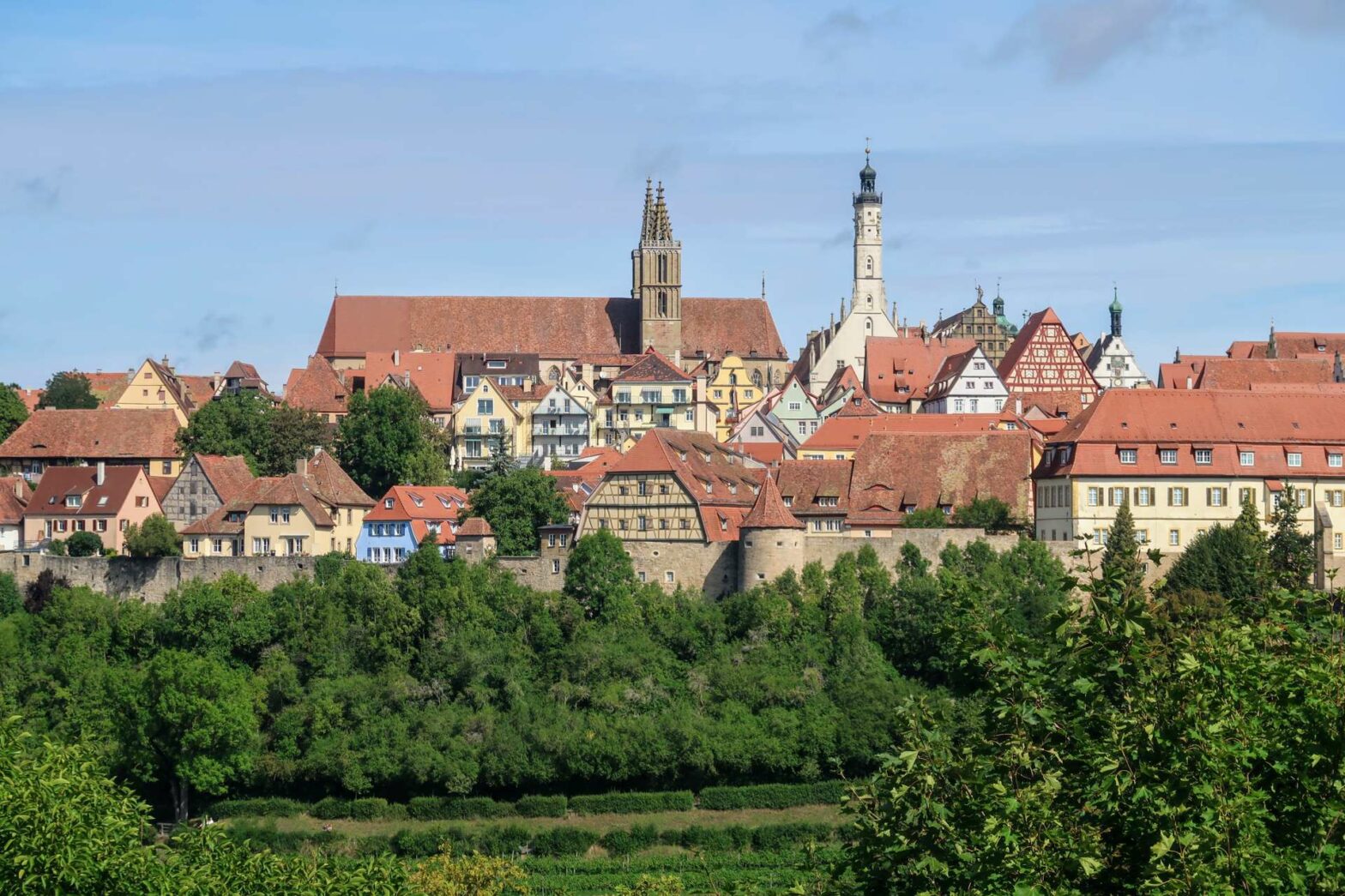
By Vicky · Published Sep. 10th, 2023 · Updated Jan. 12th, 2024
When you buy through links highlighted with an asterisk (*) on this site, we may earn a small affiliate commission at no cost to you.
Discover the medieval buildings, cobbled streets and impressive city walls on this walking tour of Rothenburg ob der Tauber, one of the top stops on the Romantic Road.
Page Contents:
This walk starts from Röderturm, a large tower at the eastern edge of the town’s historic walls. There are several car parks (P4, P5) near here, plus Rothenburg Train Station is just a few minutes walk away. It’s 1-3 hours from Würzburg, Nuremberg, Augsburg or Munich on the train. From Munich, you can also go on guided day trips by bus *.
Get the route by downloading the .gpx or .kml file below. For navigation with Maps.me on your mobile phone, simply download the .kml file and open to add it to the Maps.me bookmarks.
Tips for Rothenburg ob der Tauber Walking Tour
- It can be quite touristy, especially in summer, but it’s definitely worth it. Tourists tend to leave in the evening.
- Spending a night in Rothenburg is worthwhile since the buildings are elegantly lit and the tourists have mainly disappeared.
- There’s a very cute Christmas Market here in December on the market square.
- You must try Schneeballen – dough balls coated in sugar, chocolate and more – when in town.
- Why not also explore the cute town of Donauwörth , or the historic city of Nuremberg , both easily reachable on the train.
- Check out other walks on our Germany Hiking Page .
Top Sights in Rothenburg ob der Tauber
On this self-guided walking tour you’ll see the main sites and attractions of Rothenburg ob der Tauber. One to two days is the perfect amount of time to spend in Rothenburg . Try and stay for the night, as the town is at its best in the early evening and mornings.
- Alt-Rothenburger Handwerkerhaus
- Rothenburg Marktplatz
- Jakobskirche
- Rothenburg Museum
- German Christmas Museum
- Scheidgasse
- Medieval Crime Museum
- Das Plönlein
- Spital Bastion
- Town Valley Walk
Rothenburg ob der Tauber Walking Tour Route
This walking tour starts from the Röderturm. It heads first into Rothenburg Altstadt * before heading around the medieval city walls An extension heads across the Tauber River Valley for great views back to Rothenburg and of the historic Double Decker bridge.
1. Röderturm
The Röderturm * is a grand old entrance to Rothenburg. It’s a beautifully preserved and well-fortified gate to the city leading through the town walls and into the heart of the medieval town itself.
Directions: Head through Röderturm and into the old town along Rödergasse street.
2. Markusturm
The Markusturm is a rather beautiful inner city gate, unusual for its location right in the middle of town rather than along the city walls. Several historic, half-timbered buildings and cute streets surround the tower. There’s a stork’s nest at the top of this tower which may be occupied in summer!
Directions: Briefly head left down the quiet street just before the tower. Shortly on your left you’ll see the next stop.
3. Alt-Rothenburger Handwerkerhaus
Key Information: Open Apr-Oct 11-3pm, closed Mondays. Open Dec 2-4pm every day. Entry is €3.
The Alt-Rothenburger Handwerkerhaus * is a living museum where craftsmen and women have made their living making and selling goods for over 700 years. In the museum you can take a peak into what life has been like for craftspeople for over 1000 years, and there are still craftspeople working here today
Directions: Continue down the main street and you’ll soon find the main square.
4. Marktplatz
The Marktplatz * is the main square and lies at the heart of Rothenburg ob der Tauber. It’s surrounded by many colourful half-timbered houses such as the Marien Apotheke, and the grand Town Hall (Rathaus). You can go up the tower in the Town Hall (for a fee) for stunning views over town the the Tauber River Valley below. The tourist information is in the white building with the clocktower if you want a paper map of the town or information about the surrounding area.
Directions: Leave the square along the street to the right and you’ll find the large church.
5. Jakobskirche
Key Information: Open Mon-Sat 10-18 and Sun 11-18. The church is closed during mass. Entry to the church is €3.50. Audio guide an extra €2.
Jakobskirche * is a beautiful Gothic church and the main church in town. It’s also the only church with an admission fee. The most famous object in the church is the Heilig Blut Alter (Sacred Blood Alter) carved by mastercraftsman Tilman Riemenschneider. You’ll find this artwork behind the organ. Note the cross above the Last Supper, which apparently contains a holy relic – three drops of the blood of Christ. Don’t forget to also check out the beautiful stained glass windows. If you listen to the audio guide, the art and history section is better than that about spirituality.
Directions: Go through the tunnel beneath the church and take the first left. The museum is up the street to your right.
6. Rothenburg Museum
Key Information: Open Apr-Oct: 9.30am – 5.30pm, Nov-Mar: 1-4pm. Tickets are €5.
The Rothenburg Museum ( Website , Tripadvisor Reviews *), also known as the Reichsstadt Museum, contains the oldest convent kitchen in Germany, plus weapons and armour, and the museum is in a former Convent/Dominican Monastery. There’s a barrel outside the entrance – where nuns gave sustenance to the poor, and destitute women left their babies if they couldn’t afford them. The displays are well presented and you could spend a couple of hours looking around the museum.
Directions: Head through the gate to the left of the museum and into the Kloster Gardens. These are small but a lovely, relaxing place for a break. Walk through the gardens and leave via the gate to the left. Turn left on the road, then left again to the large tower.
History of Rothenburg ob der Tauber
Rothenburg ob der Tauber was almost destroyed in the 30 Years War (1618-1648) by the Catholics, led by General Tilly. It was saved when the townspeople gave the General a lot of money. But if you want a more romantic story, General Tilly challenged the Mayor to down three liters of wine. If the Mayor succeeded, the General would leave the town in peace. The Mayor somehow downed the wine and the town was saved.
The Burgtor is an impressive gateway between the old town and the castle gardens. The gardens are lit atmospherically after dark, as is the gate.
Directions: Walk through the tower, turn left, left and left again back to the front of the tower and Herrngasse street. You’ll explore the castle gardens further when walking around the town walls.
8. Herrngasse
Herrngasse is a wide road lined by stately buildings, more recent than some of the oldest buildings in town. The name comes from the Herren, or gentlemen (rich merchants) who lived along this street in Medieval times.
Directions: Walk along the street and you’ll see the famous Christmas shop on your right.
9. German Christmas Museum
Key Information: Open Apr-Dec: 10am – 5pm. The shop is free to look around, but tickets to the museum are €5.
The Christmas Museum ( Website , Tripadvisor Reviews *), or Deutsches Weihnachtsmuseum, is within a huge Christmas shop called Käthe Wolhlfahrt Weihnachtsdorf. In the museum, you can learn about the history of Christmas and its traditions plus see Christmas decorations from different time periods. Even if you don’t visit the museum, it’s worth going into the store where you’ll be transported to a winter wonderland of Christmas! You can also buy many high-quality Christmas decorations here, if you feel the need.
Directions: Head through the square and take a right on the main street.
10. Schneidgasse
Schmiedgasse * is a long, cobbled street in town full of character. Quaint shops, bakeries, cafes and restaurants line this street. Schneidgasse is a great place to try Schneeballen – a specialty of Rothenburg. Schneeballen are large dough balls covered in any variety of toppings. The original ones are just dusted with powdered sugar, and these can be a little boring. Opt for the exciting flavours instead!
Directions: Walk down the first street on your right and pass the church to visit the next museum.
11. Medieval Crime Museum
Key Information: Open Apr-Oct: 10am – 6pm, Nov-Mar: 1-4pm, with longer hours in December. Tickets cost €9/4.50 for adults/children.
The Medieval Crime Museum ( Website , Tripadvisor Reviews *) is the most popular museum in Rothenburg ob der Tauber. It’s about criminals and how they were treated in the Middle Ages. Mostly they were tortured and you can see all the torture instruments in this interesting museum. You’ll also find out about the justice system during the Middle Ages and find many unusual and intriguing exhibits.
Directions: Head back to Schneidgasse and continue down the street.
12. Das Plönlein
Das Plönlein is the most photographed spot in Rothenburg and perhaps the whole of Germany! You’ll see it on the front of many travel guides and brochures. The photo of Das Plönlein has become the symbol of Rothenburg ob der Tauber, and it’s very cute indeed. Try and arrive early or late to beat the crowds, though it can also be surprisingly quiet in the peak hours of the day.
Directions: Walk onwards down the main street to the large gate at the end.
13. Spital Bastion
The Spital Bastion * is a fortress-like gate in the town walls, added in the 16th century. It’s the best town gate because it’s more of a mini fortress in itself, and you can walk through it. For now, head up the steps to the left of the gate to get onto the town walls. You’ll return here after a loop of the walls and can more fully explore the Bastion.
Directions: Climb the steps to the walls and turn left to start an anti-clockwise loop of the old town.
14. Town Walls
You can walk 4 km all the way around the town walls *. The first half is the most complete and there are several towers to see on the way. There are also great views across the rooftops of town, and of several lovely buildings. One of these is Gerlachschmiede *, a beautiful red-and-white half-timbered building.
After this building, you’ll reach Röderturm, where you started this walking tour of Rothenburg ob der Tauber. You can go up the tower itself (for a small fee) to see the views, but the opening hours are rather sporadic. The next larger tower you’ll come across is Kingertour *, at the northwest corner of town.
You have to leave the walls at Kingertour. If you head through the tower, you’ll come to St. Wolfgang’s Chuch, connected to the defensive Kingertour Bastion. To continue the walk around the walls, take the left on the outer side of the dry moat, signposted ‘Detwang’. Continue walking on this path as it parallels the city walls. You’ll pass a few more towers, then can enter the town again near the Burgtor.
Exploring the Castle Gardens
You’ll now be in the Burggarten *, or Castle Gardens. This park covers a promontory with views over the River Tauber Valley. Head around the edge of the park and back towards the town, where you’ll have some great views. Just after the little chapel, take the right heading downhill and back out of the Medieval Walls.
Strolling through the Vineyards
Turn left to walk through the sloping vineyards, with more great views of the Tauber Valley below and the old town above. Keep on going at roughly the same height, and eventually you’ll reach a tower in the walls on your left. You can take a peek inside the gate, but you can’t walk along the walls for any distance here. Instead, continue to the right and you’ll soon reach the next tower, Kalkturm.
Head through the tower and take a short moment to explore the peaceful courtyard, full of large old farming and milling buildings. When you’re ready, head up the steps and back onto the walls. There’s a down and up some steps, then along to the next tower. Descend this tower to walk through the moat.
Back to Spitalturm
You’re almost at the end of the town walls walk, and soon you’ll be at the base of the grand Spitalturm. Head up the stairs, and into the round fortress itself. You can walk through here all the way around to the other side. When you leave the building, turn right back along the moat then up the stairs to your left. Cross over the wooden bridge and you’ll be back at the end of the long street.
Directions: Head up the street to return to the main square. From here, explore the town centre further, go on the Tauber Valley Walk (see below) or make this the end of the Rothenburg ob der Tauber Walking Tour.
15. Tauber Valley Walk
If you still have the energy, a walk through the Tauber Valley is a lovely way to end your tour of Rothenburg ob der Tauber. You can start this walk either from the Spitalturm, or beyond Jacobskirche at the other end of town.
On this peaceful walk you’ll stroll along the River Tauber, see the funny Topplerschlösschen, and walk across the Doppelbrücke (double bridge). There are great views from the bridge of Rothenburg ob der Tauber above, perched at the top of the cliffs.
Tours of Rothenburg ob der Tauber
If you want to go on a guided tour of Rothenburg ob der Tauber, there are tours from the tourist office. These are daily, normally at 2pm in English, and last around 90 minutes. In the evening, a night watchman (Nachtwächter) leads a fun tour of the old town, starting at 8pm from the Rathaus. If you’re visiting from Munich, you can also take a guided day trip to Rothenburg *.
Best Places to stay in Rothenburg ob der Tauber
There are plenty of accommodation options in Rothenburg. They tend to get full in summer, especially on weekends, so book in advance as soon as you know you’re going. It’s definitely worth spending a night in Rothenburg as the town quietens down in the evening when many of the tourists have left. Additionally, the town looks rather beautiful lit by the street lamps.
- Hotel Reichs-Küchenmeister *: This historic hotel right in the centre of town, with lovely rooms, a great breakfast and dining rooms full of character.
- Hotel Rothenburger Hof *: A great value hotel just opposite the train station, 10 minutes walk from the old town. Free parking and clean rooms make this a great choice for budget travelers.
- Hotel Zum Breiterle *: Another historic hotel inside the city walls, this good value hotel has everything you need to enjoy your stay in town.
- Youth Hostel Rothenburg Ob Der Tauber *: From twin rooms with private bathrooms to cheaper dormitories, you can’t stay in a more historic building than this. It’s located in the Rossmühle, a huge old mill and a landmark in town.
For more walking tours and hikes in Germany, see our Germany hiking page .
FAQS – Rothenburg ob der Tauber Walking Tour
Rothenburg ob der Tauber is known for its Medieval town centre and well-preserved defensive walls and towers. It’s also known as one of the best towns to visit in Germany.
Rothenburg ob der Tauber means ‘Red Castle above the Tauber River’.
The best thing to do in Rothenburg ob der Tauber is a walking tour through the old centre and along the well-preserved city walls.
You’ll need at least one day to explore Rothenburg ob der Tauber, or more if you want to visit more than one of the museums. Rothenburg is best experienced in the early mornings or evenings when most of the tourists have left, so spending a night in town is a great idea.
Related Posts
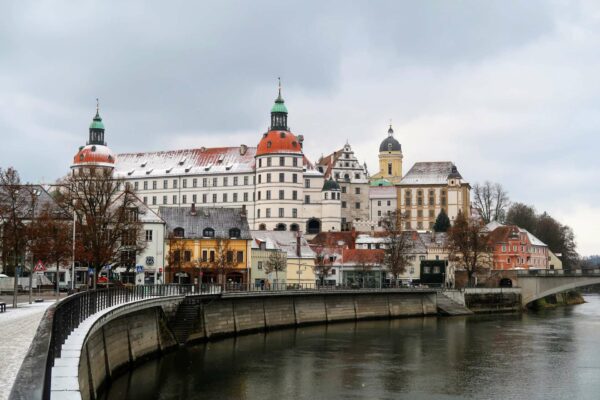
Neuburg an der Donau Walking Tour
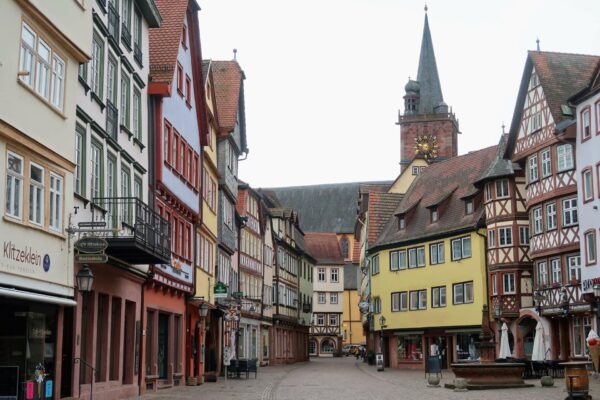
Wertheim Walking Tour
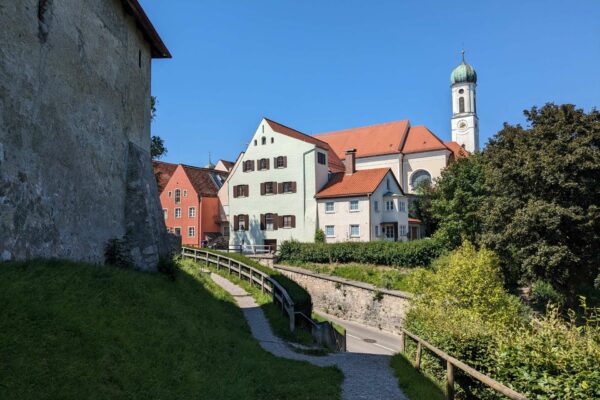
Schongau Walking Tour
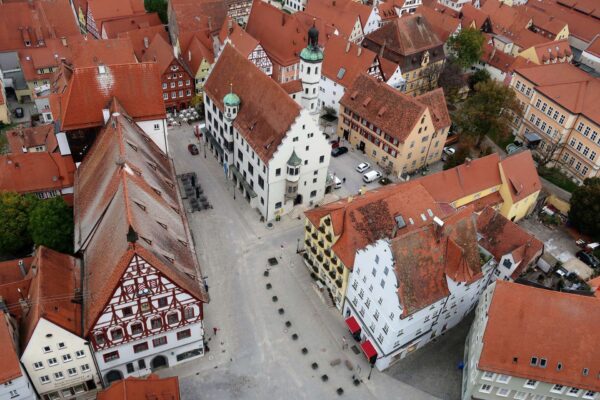
Nördlingen Walking Tour
Leave a comment cancel reply.
Your email address will not be published. Required fields are marked *

Germany > Rothenburg > Rothenburg City Wall Walking Tour Map
- Rothenburg Overview
- Top 10 Things To Do
- Top 15 Hidden Gems
- Old Town Walking Tour
- City Wall Walking Tour
- Christmas Market
- Imperial City Days Festival
- Getting To Rothenburg
- Top 10 Hotels
- Best Restaurants

Rothenburg City Wall Walking Tour:
Walking Tour Location : Rothenburg City Wall Trail ( Turmweg ) Cost : Free, Self-Guided ( Museum and funicular/lift costs below ) Style : Do-It-Yourself Walking Tour ( Self Guided ) Start : Old Town Square ( Marktplatz ) End : Saint Wolfgang Church ( St. Wolfgangskirche ) Walking Distance : 2.9 miles for the full circle route ( +0.9 for Old Mills; +0.3 for Toppler Palace ) Time Required : 2-2.5 Hours For Full Walk With Sights ( +60 Minutes for the Crime Museum ) Short Route : In a 0.9 minute, 30 minute loop you can do the short route with stops 1-5 and then head back to Market Square. Fun Scale : 10 out of 10
Overview Of The City Wall:
If the colorful half-timber houses and cobblestone alleys of Rothenburg weren’t magical enough on their own, the village is also encircled by a timeless Medieval wall. As early as 1142AD, sections of the fortified stone wall were protecting the young trading center and its royal castle.
After being named a Free Imperial City in 1274, the fortifications were strengthened, the watchtowers were enhanced, and the wall was expanded as the city grew. Rothenburg grew to be the 2nd largest city in Germany by 1400 thanks to the wool trade and markets that prospered behind the protection of the 2-mile long city wall.
While the castle is long gone, the wall, its covered ramparts walkways, and many of its towers have been well preserved for your enjoyment. This preservation is because the city never expanded and modernized due to financial hardships after the 30 Years War in the 1600s and because citizens came together after WW2 to sponsor restoration from damage caused by bombings. We hope you enjoy our Rothenburg city wall walking tour as taking even a brief stroll along it shows you a side of the beautiful village that many tourists miss.
Suggested Walking Route:
Our suggested City Wall Walk route is a grand tour loop of everything worth seeing along Rothenburg’s city wall trail ( Turmweg ) which will take 2-3 hours for most visitors. For a shorter taste, you can also do a 0.9 mile loop from Market Square through stops 1-5 and back which only takes around 30 minutes.
Many visitors do this wall walk in conjunction with our Old Town walking tour which ends at Plönlein Corner. To join the two, you’ll start your city wall walk in Plönlein Corner and work your way through stops 12 to 1 in reserve order. If you are in Rothenburg for a few days, you will also want to pop out to the Old Mills Path, Panoramic Vineyard Trail, and Mayor Topper Route which are all short and marked on our map.
1. Marcus Tower & Arch ( Markusturm ):
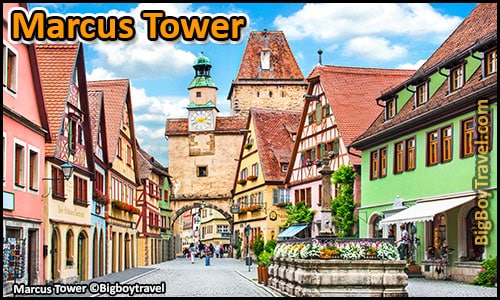
About Marcus Tower : As you leave Market Square on the road that once led to Nurmenburg you quickly see part of the original town wall at Marcus Tower. In the late-1100s this was the outer edge of the first city wall with access through its timeless Woodsman Archway ( Röderbogen ) . This Medieval gateway with a stubby clock tower was part of the first ring wall protecting the early village.
By 1204, the first town wall had 4 watchtowers including the Red Tower ( Roter Turm ), White Tower ( Weißer Turm ), Blue Tower ( Blauer Turm ), and Marcus Tower ( Markusturm ) built here behind the archway. This intimidating tower has a lower level with walls that are 6 feet thick walls which housed a prison until 1844. Make sure to look at the roof of Marcus Tower where an elevated nest serves as a nursery for a family of storks in the Spring through Fall.
As you pass through the Marcus Tower archway, the half-timber homes lining the road was stunning and create a beautiful backdrop when taking photos of the front of the gate. Maybe the best vantage point is near the flower-laden Woodman’s Well ( Röderbrunnen ) . Because of how wide the well is, it once served as a birthing fountain ( Tränkbrunnen ) in Medieval times. Each Spring the Röder Well is one of the main fountains in Rothenburg that gets decorated with Easter eggs to bless the water. The hollow eggs that elaborately cover the Easter Fountains ( osterbrunnen ) are brightly painted and strung to form a beautiful garland.
2. Blacksmith’s Shop ( Gerlachschmiede ):
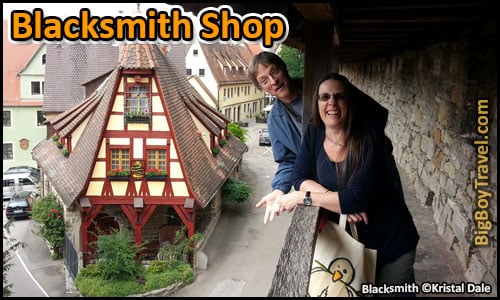
About The Blacksmith House : One of the most playful buildings in Rothenburg is the uniquely shaped, half-timber Blacksmith House which was built on a triangle corner lot in 1469 . After being badly damaged in World War 2 bombings, the historic home was rebuilt in 1951 and served as an active blacksmith shop for Georg Gerlach until 1967 when it became a private residence again.
Most tourists admire the former Blacksmith Shop from above while strolling the city’s ramparts, but if it looks like something if you want to see it up close we highly recommend it before starting your walk on the wall. The southern front of the home is the most famous as it is where the unique shape of the home is shown off the best. We love the details of the front facade from the roofline hoist to the coat of arms depicting a crowned green snake holding blacksmith tools. The north side of the home is also stunning with an interesting horse-shoed carriage door that was once used to unload goods and a medieval-style iron business sign with blacksmith tools and the year 1469 highlighting the structure origins.
Filled with decorative wrought-iron business signs, it doesn’t take long for visitors in Rothenburg to realize how important blacksmith still is to this day in town. If you happen to visit Rothenburg during one of the Summer or Fall festivals you can often see blacksmiths working their irons in Green Square ( Grüner Markt ).
Insider Tip : We suggest visiting the Blacksmith Shop before climbing the stairs up the wall at the Röder Tower ( Röderturm ) as the next set of steps isn’t until the Ruckesser Tower 400 meters ( 1/4 mile ) further down the wall. Seeing the shop up close before you pass by while doing the elevated city wall walk will help you better identify the different hidden blacksmith elements from above.
3. Röder Tower & Gate ( Röderturm & Tor ):
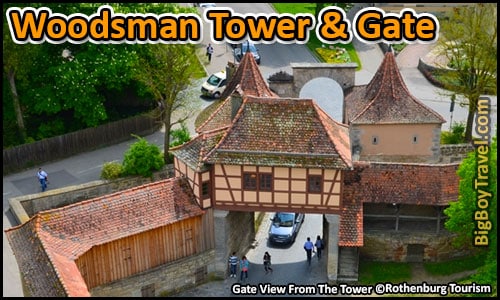
About Röder Tower : As the city wall expanded outward starting in 1208, it multiplied to include a staggering 70 watchtowers ( 42 still preserved ) and the Röder Tower ( Röderturm ) was the most impressive. With its perfect vantage point, this is the only true observation tower along Rothenburg’s town wall. Every night, one of the city watchmen in the Röder Tower would signal back to the city center letting everyone know that either all was well or that danger was on the way. This is the only tower along the wall that you can climb to the top ( 103 steps ), and it houses a special exhibit about the tower to go along with the views.
Sitting in front of the watchtower is the Röder Gate ( Rödertor ) which you need to visit before climbing the wall. As you exit the multi-stage gate , two stone bridges ( formerly drawbridges ) lead you over the town’s dry moat as you pass armed curtain walls, guardhouses, an elevated gatekeepers cottage, and go through three archways to reach the end. The beautiful twin huts with pointed roofs at the end were used as a toll booth and customs house starting in the 1300s. Seeing the full Woodsman Tower Gate from the outside will let you experience how formidable it was at protecting the city. After backtracking through the gate system, you are ready to climb the stairs and start walking on Rothenburg’s wall.
It is also interesting to note that the name Röder, which roughly means Woodsman in German , derived from the small hamlet called Röder that once sat just outside Rothenburg in this direction. The small hamlet settlement, no longer exists you can see a common pattern in Rothenburg where the roads and gates were often named for the destinations they pointed toward.
Observation Room Hours : Daily March-October & December 10am-5pm; weather permitting; November & January-February. Observation Room Cost : 2€ for adults; 1€ for children. Access Onto The Wall : There is a fee for the upper observation room, walking onto the wall is always free and open 24 hours a day all year.
4. Rotten Tower Stroll ( Faultrumweg ):
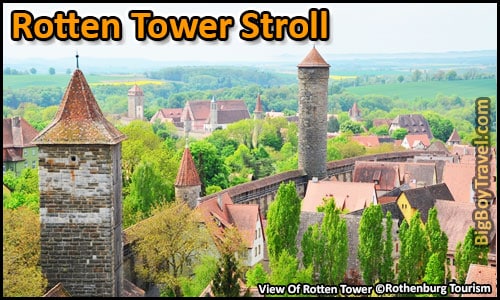
About The Rotten Tower Stroll : As you pass the Blacksmith’s house, the next stretch of Rothenburg’s city wall is the most popular for tourists to walk along. The views of the village’s skyline from the wall are excellent and you get to stroll below the Rotten Tower. The Rotten Tower was built from 1385-1400 to house serious criminals as is one of the only round city wall towers in Rothenburg.
Make sure to also take a look at all of the stone plaques inside the wall with family names on them. During WW2 Allied planes dropped bombs on the north side of Rothenburg, killing 37 people, destroying 306 houses, 6 public buildings, 9 watchtowers, and damaging over 2000 feet of the wall. Luckily through generous donations, the damage was able to be restored close to its original state. Many of the donations came from people sponsoring 1 meter long sections of the wall by buying plaques with their family names on them. When it started in 1950, each sponsorship cost $40 per meter and is now over $2000 a meter. As you walk the wall make note of the various plaques from sponsors by local and foreign.
5. Sifter Makers’ Tower ( Siebersturm ):
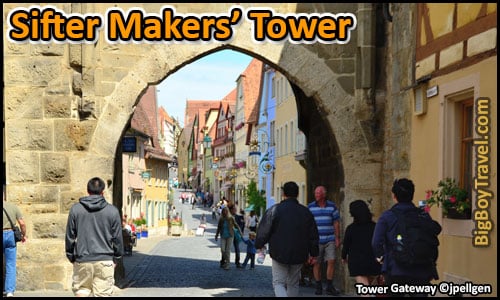
About Sifter Makers’ Tower : Walking downhill from the city wall, you will come to the Sifter Maker’s Tower ( Siebersturm ) which was added in 1385 as part of the new fortifications. The tower was originally called the Inner Gebsattler Tower when it was adding above the archway, but was later renamed for the Association of Flour Sifter ( Sieve ) Makers . The view standing on the Southside of the tower and framing up old town Rothenburg to the North inside the tower’s archway is one of the most magical in Rothenburg.
If you look up at the coat of arms shields on the tower, the red twin tower castles are the symbol of Rothenburg while the black eagle with a yellow background was the crest for the Holy Roman Empire in 1274 when the town was elevated to a Free Imperial City. Some people are confused by the icon as the Empire later switched to a double-headed eagle holding a shield.
Along the south side of the tower is the Landwehr-Bräu Tavern ( website ) housed inside a beautiful yellow medieval house . This small restaurant is known for having great beer and very affordable food as it caters a little more toward locals with its later hours. As part of the decor inside they have a really cool clock with a miniature version of the Master Draught from the facade of Rothenburg’s Council Drinking Hall.
Restaurant Hours : Tuesday-Friday 5pm-midnight; Saturday 3pm-1am; Sunday 3-11pm; Closed Mondays.
6. Infirmary Quarter ( Spital ):
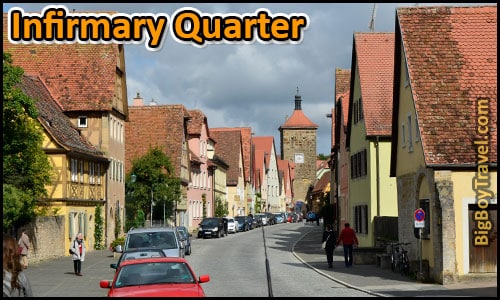
About Infirmary Quarter : While originally centered on the Parish of Detwang on the Tauber River, in 1080 the village of Rothenburg started to move up the hill. One of the first buildings up the hill was a small fortress for the Counts of Komburg on the so-called “Vinegar Jug” near the Infirmary. When the first city walls were built in the early-1200s, the neighborhood was left outside of the walls.
In 1280, a religious order called the Knights of the Hinterland established a hospital to help the sick and poor called the Holy Ghost Infirmary. The Infirmary was eventually enclosed by the city wall in 1370, but a large fire in the 1500s required most of the hospital complex except the Holy Ghost Church to be rebuilt.
7. Hospital Tower & Bastion ( Spitalturm ):
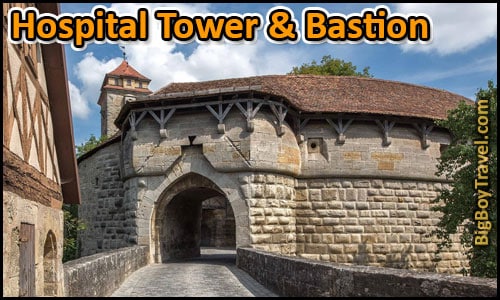
About Hospital Tower & Bastion : When the Infirmary was incorporated by the city wall in 1370, a gate to be built here to serve as the new Southern entrance into Rothenburg. The defenses of the gate were greatly enhanced in 1586 when the tall gate tower and figure eight shaped bastion were added on. The Bastion has 2 inner courtyards, has 7 gates, an upper walkway, and is surrounded by a dry moat you can walk in. We could spend a solid hour wandering through the figure eight just admiring the exposed beams and covered bridge. The Latin inscription over the outside of the gate says: “Peace to those who enter; Farewell to those who leave.”
8. Hegereiter House :
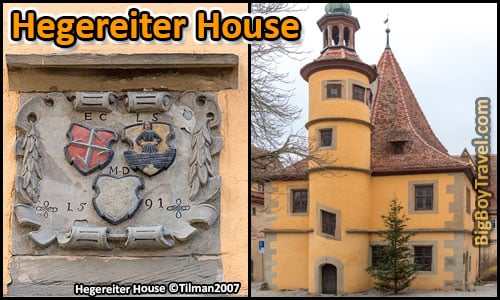
About Hegereiter House : Built in 1591, this funky-looking building is the former Infirmary hospital kitchen and the uniquely shaped wooden roof follows the curves of the original tent roof. While the lower level was the kitchen, the loft area of the Hegereiter House doubled as the home of the manager who was in charge of multiple Infirmary properties. Like the Spital Bastion, this house was built by the local master builder and famous stonemason Leonard Weidmann.
9. Little Flushing Tower ( Stöberleinsturm ):
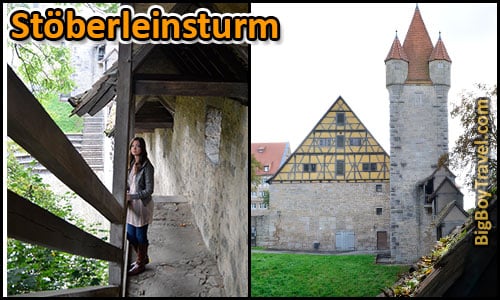
About Stöberleinsturm : The gorgeous Stöberleinsturm watchtower is the only one in Rothenburg with its original Medieval roof and has corner turrets which most of the other towers also had. Built outside the first city walls, the tower, and connected building served as a hospital and center for the poor. Today there is a wonder open-air theater below the tower called Stöberlein’s Stage ( Stöberleinsbühne ) which hosts lively outdoor plays during Rothenburg’s festivals. The natural bowl of the theater butts up against a wonderful multi-tiered section of the city wall which is our favorite section to walk in the city.
Outside of Rothenburg’s city wall near this tower once was the Vinegar Jug Castle ( Burgstall Essigkrug ) which was built by the Counts of Comburg around 1080. The Counts oversaw this part of Franconia including the nearby parish in Detwang as early as 970 from their court in Schwäbisch Hall. While their fort was half the size of the Hohenstaufen Castle built nearby in 1142, it was an important vantage point for protecting the Tauber River below.
By 1115, Conrad III Hohenstaufen ( whose uncle was the Holy Roman Emperor ) married the daughter of the last Count of Comburg-Rothenburg just a year before the line died out. Conrad would then go on to become the Duke of Franconia in 1116, the King of Germany in 1138 , and built his own larger castle in Rothenburg in 1142, which help establish the town by 1170. We will visit the ruins of Conrad III’s former castle later on this Rothenburg City Wall walking tour.
10. Old Horse Mill ( Rossmühle ):
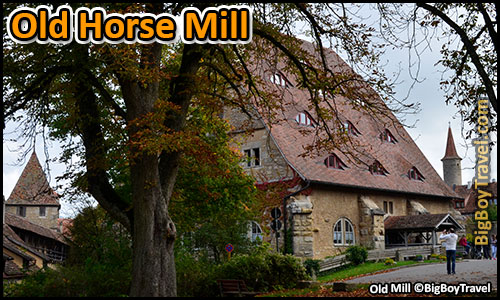
About The Horse Mill : Built in 1516 as a corn mill, the Rossmuhle was powered by 16 horses instead of with water power like other waterfront mills. The large mill is one of the best buildings in Rothenburg to photograph and we love the curved port windows in the roof. At one point it the mill was said to be the biggest in Southern Germany before time, technology, and an eventual fire caught up with it. Since being renovated in 1957, the former mill now serves as a youth hostel and is one of the most reasonably priced hotels in town.
As you continue the walking tour, just past the old horse mill along the wall you will find Rothenburg’s famous Linden tree. Planted in 1587 , it is one of the oldest trees in town The small wooden door below the Fish Tower ( Fischturm ) has an ancient sign marking the planting of the now gnarly tree. Liden Trees have been a prideful thing in the region as Walther von der Vogelweide, who was the most famous early-medieval German lyric poet, wrote a poem about love around 1200 called Under The Linden Tree .
Hostel Website : ( HERE ).
11. Kobolzeller Tower ( Kobolzellertrum ):
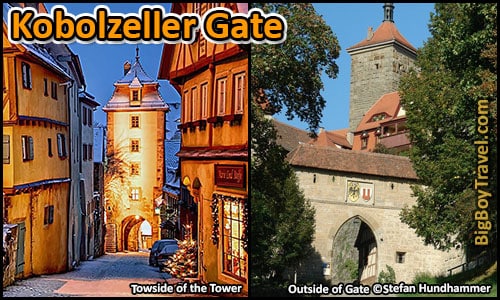
About Kobolzeller Tower : Leading up from the Tauber River Valley, the Kobolzeller Gate has numerous extra layers of protection from unwanted visitors entering Rothenburg. Following the Earthquake of 1356, the Kobolzeller Gate was expanded into a 4 gate kennel system complete with two towers. You can walk across the gate’s bailey wall to the Devil’s Pulpit in front of the tower to shoot invaders square on.
The tower was named after the tiny Kobolzell settlement that once lay below Rothenburg along this stretch of the Tauber River Valley. Today only the Kobolzeller Church, the Double Bridge, Lords Mill Inn, and a few residential houses remain from the hamlet settlement. If you take the steep path down to the Tauber River you can get an excellent photo back up the hill of the Kobolzeller Gate through the trees.
12. Little Square Corner ( Plönlein ):
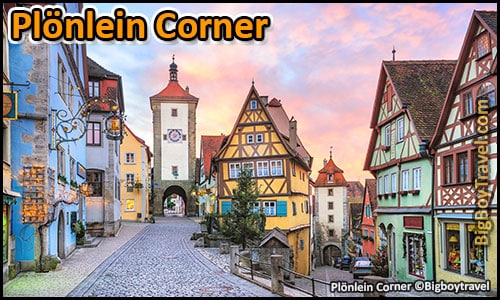
About Plönlein Corner : Meaning Small Level Area in Latin, the postcard-perfect shot you were looking for, Plönlein Corner is the most iconic image of Rothenburg . The bright yellow half-timbered house is almost jaw-dropping. Get there before or after the tour buses roll in to get great photos with the square free of tourists. Also, make sure to check out the cool flower bed made out of a former well fountain in front of the home. Plönlein means a small level area, but it’s the change in elevation in the split of the road that makes it cool.
13. Panorama Trail Viewpoint :
About Panorama Trail : With wide swiping vistas of the Tauber Valley, you can see why the trail below this section of the city wall has been called the Panorama Trail. There is an elegant Baroque garden directly below the viewpoint which turns into a vast vineyard stretching out all the way to the Hohenstaufen Castle ruins. If you explore this short trail during your visit to Rothenburg, you will fall in love with the playful stone statues that line the top of the vineyard.
14. Saint John’s Church & Fountain ( Sankt Johannis ):
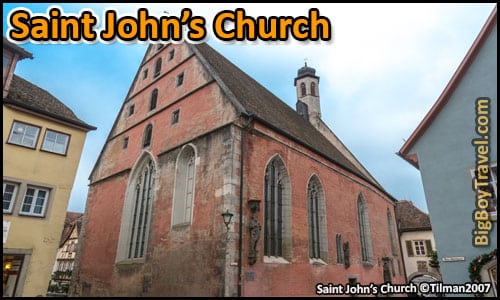
About Saint John’s Church : As the round the corner by the viewpoint, you’ll see a pair of stone fish ponds that we find to be really cool, but are often overlooked. The tanks were holding ponds to keep fresh fish on hand at the Saint John’s Monastery. The ponds once a large Mediterranean-style walk-in hut before being remodeled into their low profile form in 1856.
Supplying the water for the fish pond, the large Saint John’s Fountain ( Johannisbrunnen ) next to the church is the biggest well in town , able to hold over 25,000 gallons of water. It was built in 1608, remodeled in 1716, and is decorated with a beautiful column capped with the zodiac sign Aquarius to bless the water.
Originally built in 1200 as the gothic chapel for the nearby Saint John’s Hospital, the pink Saint John’s Church also served as the headquarters of the Order of Saint John Monks. The hospital was built just on the outside of the City Gate ( Stadtturm ) for the first city wall as to not spread infections in town.
As a small suburb started to spring up on the Southern end of Rothenburg, the city wall was expanded in 1385. This expansion also gave the church space to be totally rebuilt in its current style from 1390-1410 including the addition of the City Watchtower ( Stadttor ) on the Eastern side ( no longer exists ). Saint John’s was forced to switch to Protestantism during the Reformation, but and since changed back, and is now Rothenburg’s only Catholic church . The interior is one of the blander in town, but it is still an important place to take note of.
15. Medieval Crime Museum ( Kriminalmuseum ):
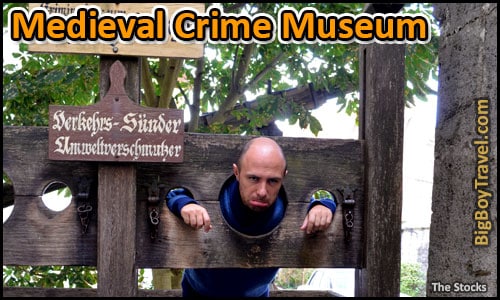
About Medieval Crime Museum : Sitting in the former monastery complex of the Monks of Saint John is the only law museum in Europe! The Medieval Crime Museum covers over 1000 years of Medieval law history, sensational criminal cases, including the persecution of witches and witchcraft in Bavaria. Our favorite items are the instruments used for torture, shaming, and punishment. The devices were used for everything from stealing, people who cheated on their spouses, and even those who gossiped too much. It is by far one of the coolest things to do in Rothenburg and helps get you into the Medieval spirit.
Museum Website: ( HERE ).
16. To Hell Tavern & Restaurant ( Zur Höll ):
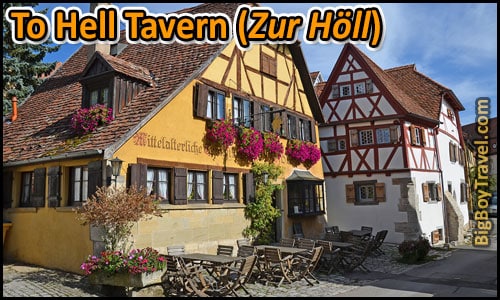
About Zur Höll : To Hell Tavern ( Zur Höll ) is our favorite restaurant in town and is located inside the oldest home in Rothenburg with a foundation dating back to 970. Known for its cozy atmosphere along with an excellent menu of Bavarian and Franconian dishes, To Hell Tavern is one of the best places to experience Medieval Rothenburg.
The name ‘Zur Höll’ comes from the Middle Ages when nearby buildings were part of the Saint John’s Monastery ( established in 1200 ). Since the monks wanted to be separated from the general public to avoid temptation, a large part of the lane was covered with a wooden roof and was closed to non-monks. The roof made the alley very dark, so it gained the nickname Hell Alley which carried over to the restaurant in modern times.
The old-world interior is best highlighted by the Medieval cellar dining area hidden in the back of the restaurant. This cave-like cellar is not only romantic but also has historic details incorporated in it. The best element is the 8-foot-long kiln blower which now serves as the table since the cellar was once used as a blacksmith forge in late-Medieval times. We highly suggest getting reservations in advance if you plan on eating dinner at the To Hell Tavern as it is very popular but does have limited seating. Although only open for dinner in the winter months, during the rest of the year this restaurant can be an excellent place to have lunch while following this Rothenburg City Wall Walking Tour.
Zur Höll Hours : Summer Sunday-Thrusday 10am-9pm; Friday & Saturday 10am-11pm. Christmas Market Daily 5pm-10pm. Winter Monday-Saturday 5pm-10pm; closed Sundays. Restaurant Reservation Requests : [email protected]. Restaurant Website : ( HERE ).
Related Video : Tour Of Zur Höll Restaurant
17. Castle Road ( Burggasse ):
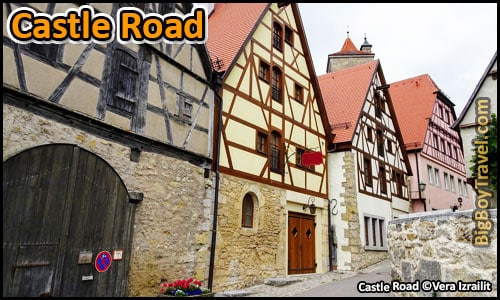
About Castle Road : As you work past the area nicknamed Hell Alley, you will hit the core of Castle Road and get a wonderful view of the Tauber River Valley over the city wall. While we will be turning right to see the royal castle ruins beyond the Barn Gate, we will also visit the other end of Castle Road at the end of this free Rothenburg walking tour.
From Rothenburg, Castle Road was actually part of 1200km trade route connecting over 70 castles that helped the early city prosper. In the East, the route extended through Nuremberg and Bamberg all the way to Prague. In the West, it went through Schwäbisch Hall and Heidelberg on its way to the French border in Alsace. Known as the Thuringian Castle Road, it was the middle route of the Saint James Way to France and brought an influx of pilgrims who called Rothenburg the Franconian Jerusalem.
18. King Conrad Hohenstaufen’s Castle ( Alteburg ):
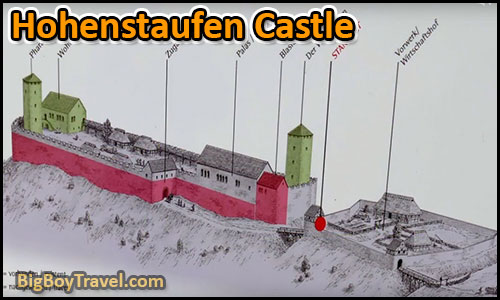
About King Conrad’s Castle : The appendix-like park on the West side of Old Town Rothenburg was where Conrad III, King of Germany ( House Hohenstaufen ) built his royal castle in 1142. This castle led to the development of the surrounding town by 1170 and gave it the name Rothenburg ob der Tauber, meaning Red Castle over the River Tauber. As you walk through the Fürbringer Barn Gate ( Burgtor ), you enter what was formerly the walled farmyard ( wirtschaftshof ) which then connected to the fort-like castle by a bridge ( see image ). Conrad chose the location because the fertile land was cheaper than administrative centers like Bamberg or Würzburg, and also because he had close ties to the area.
In 1115, Conard III ( House Hohenstaufen ) married Gertrude, the daughter of Count Heinrich II von Comburg-Rothenburg who founded Berchtesgaden in 1102. The Counts of Comburg ( died out in 1116 ) oversaw parts of Franconia at the time from their court in Schwäbisch Hall and built the small fort known as the Vinegar Jug Castle ( now gone ) on the hill of Rothenburg’s Infirmary Quarter in 1080. Conrad also came from a powerhouse family as his dad was the Duke of Swabia ( followed by his brother ), his mom’s dad was Holy Roman Emperor Henry IV, his mom’s second husband was Margrave of Austria Leopold the Good ( House Babenberg ) who developed Kerms & Vienna, and his maternal uncle was Holy Roman Emperor Henry IV. Through his bloodlines, Conrad was directly related to all previous 18 Holy Roman Emperors going back to Charlemagne the Great and was destined for the throne himself.
Just one year after the wedding Conrad III was named Duke of Franconia by uncle Emperor Henry IV. Conrad was also named Prince-Regent for Germany along with his older brother Frederick I ( Duke of Swabia ). HERE is a map of the territories at the time to understand how much land the brothers were put in charge of. When Conrad’s uncle Henry IV died in 1125, his brother lost the appointment for King of Germany in surprise fashion to a distant cousin Lothair III ( Duke of Saxony, House Welf ) who leveraged Papal support. This was the start of the feud between the Guelphs ( House Welf ) versus Ghibellines ( House Hohenstaufen ) which would later spread in Tuscany and last over 100 years. After huge military defeats and the election of Lothair as Holy Roman Emperor in 1133, the brothers eventually had to acknowledge as their ruler.
Gertrude of Comburg had died in 1131 after giving Conrad three daughters so he re-married to Gertrude of Sulzbach in 1136, whose dad Count Berengar II founded Berchtesgaden in 1102. Conrad’s brother-in-laws through the Berengar sisters gave him powerful allies including Prince Vladislav II of Bohemia ( later King ), Prince of Polish Ladislaus the Exile, and Byzantine Emperor Manuel I. With his bloodlines and new alliances, Conrad III was quickly elected King of Germany in Coblenz ( March 1138 ) after Lothair died ( December 1137 ), snubbing Lothair’s son-in-law and heir, Henry The Proud ( Duke of Bavaria & Saxony, House Welf ). Because Henry the Proud didn’t support him, Conrad striped Henry of the Bavarian duchy and gave it to his half-brother Leopold Leopold the Generous ( House Babenberg ) who also control the Margrave of Austria.
The newly crowned King Conrad III grew to be one of the most powerful men in Europe over the next 14 years and seemed destined for the Holy Roman Empire Crown which had sat vacant since Lothair’s death. Before leaving in 1147 with 20,000 troops to fight with Louis VII of France in the 2nd Crusade, Conrad III arranged for his sons Henry Berengar ( then 10 years old ) and Fredrick IV ( then 2 ) to be named Co-Kings of Germany ( Prince Regent ) with him in Regensburg to take over in case he died in battle. He participated in the ill-fated Siege of Damascus ( 1148 ) and returned to Germany.
Henry Berengar, who was once betrothed to the Princess of Hungary, was the winning general at the Battle of Flochberg ( 1150 ), but died later that year. Soon after, Conrad III died on the 15th of February 1152 at Bamberg ( buried at Bamberg Cathedral ) of malaria. The title King of Germany then went to Conrad’s nephew Frederick Barbarossa ( Emperor 1155-1190 ) who had fought with him in the 1st Crusade instead of his own six-year-old son Frederick IV ( 1145–1167 ). It was a bit controversial as only Frederick Barbarossa and the prince-bishop of Bamberg were at his deathbed to hear the order.
Frederick IV was given his dad’s castle in Rothenburg and named the Duke of Swabia, but the Duke of Franconia title went to the Bishop of Würzburg. Frederick IV took part in his cousin’s campaigns in Italy where he died from disease after occupying Rome in 1167 at the age of 21 and with no heirs. Emperor Barbarossa’s heirs produced three more Holy Roman Emperors and several Kings of Germany before the Hohenstaufen line died out in 1254. Because it sat on the crossroads of two major trade routes, Rothenburg then gained Free Imperial City statue in 1274 by Rudolf I King of Germany ( Habsburg Dynasty ).
After Duke Frederick IV’s death in 1167, his dad’s castle was only lightly used . The last Hohenstaufen King of Germany ( Conrad IV ) only stayed at Rothenburg Castle seven times between 1238 and 1251, then it sat mostly vacant as Imperial Property, and was eventually ruined by an earthquake in 1356.
19. Castle Ruins & Garden ( Burggarten ):
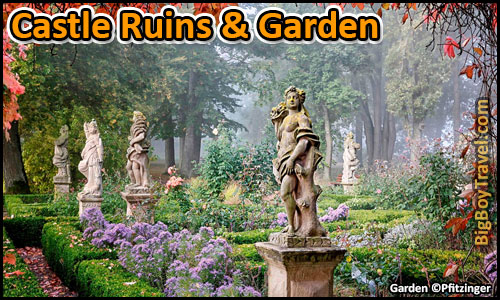
About Burggarten : In 1356, Castle Hohenstaufen was ruined by a large earthquake ( known as the Basel Quake ) which also damaged sections of the old city wall. In 1380, the Emperor sold the ruined castle to the city and allowed much of the stone to be quarried to repair and bolster a growing Rothenburg’s fortifications. Quality stone was a precious commodity at the time and the 820 feet ( 250 meters ) long and 130 feet ( 40 meters ) wide fortress had a lot of it.
In 1400, Mayor Toppler decided to rebuild the former castle’s Upper Ducal House into what is now the Chapel of Saint Blaise. As this royal castle didn’t have a chapel, the original Ducal House was connected to King Conrad’s private quarters and where he received guests during his visits. At the time of Toppler’s work, Rothenburg was the 2nd largest city in Germany with 6,000 residents and one of the 10 largest in the Holy Roman Empire.
Against the north side of the Ducal House, look for the stone Jewish Memorial from the Rintfleisch Massacre of 1298. At the time Rothenburg’s Jewish community lived along the outside of the original city walls, but had to seek refuge in the Hohenstaufen Castle for three days when a traveling mob arrived to kill them in religious persecution. With the help of local Christians, the mob burned and killed a majority of Rothenburg’s 500 Jewish residents including women and children. Before being stopped, the mob had ravished 146 communities in Franconia killing over 20,000 Jews. While parts of the old Jewish Quarter remain near the White Tower, the community was officially banned from Rothenburg in 1520. In more recent times, a second memorial was added inside the chapel for German soldiers who died in WW1 & WW2.
Roaming further down the former castle grounds, you’ll run into the orange Garden House ( Gartenhaus ) cottage which was once the main entrance into Hohenstaufen Castle. The cottage was built over the foundations of the ancient gatehouse in the 1600s and still incorporates the old Romanesque archway into its Eastern facing facade. Although not castles in the 1100s didn’t have pleasure gardens, the Westwise of the cottage has a lovely Baroque Castle Garden ( Burggarten ) in what was once the fortress’s main courtyard. The garden has beautiful geometric flower beds with 8 sandstone statues representing the 4 seasons and 4 elements. We love taking photos of the statues framed up with vines hanging from the wooden trellis tunnel. The garden is one of the best places in Rothenburg to relax, offering great views of the Infirmary Quarter skyline and the Tauber River Valley below.
As you reach the Western end of the former castle grounds you will even get to look down at Mayor Toppler’s unique top-heavy home along the river. This end of the castle had a watchtower and three-story manor house. A memorial stone was added in the Castle Park in 1908 honoring the 500 year anniversary of the death of the famous Mayor.
20. Castle Gate & Tower ( Burgtor & Turm ):
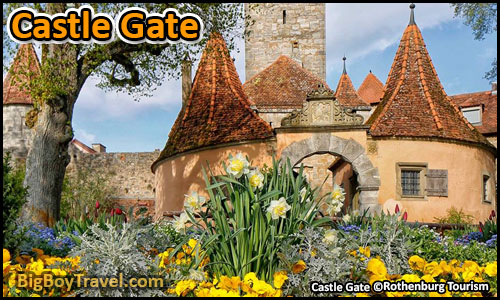
About The Castle Gate : While the Fürbringer Barn Gate was the original entrance into the castle grounds, traffic shifted to Castle Gate ( Burgturm ) which connected to the grounds to the Market Square. After Castle Hohenstaufen was destroyed in the earthquake of 1356, they needed to enhance their defense on the West side of town. They decided to super-size the Castle Gate ( completed in 1460 ), adding the town’s tallest watchtower, a drawbridge, and other protective measures. Two small gatehouses were built in front of the Castle Gate to help funnel in traffic and thwart would-be attackers.
Just inside the gatehouses, you’ll see a decorative mask that has a mouth hole the guards would use to pour hot tar on attackers. On the sides of the mask, you’ll see two large slots where chains were fastened to raise the gate’s drawbridge. In Medieval times, all of the city gates were locked at sundown so you would have to pay a fine at the gatehouse to get in after dark. You would also have to enter a special Eye-of-the-Needle door with a small opening only big enough for one person at a time, known as the manhole. The current wooden manhole door dates back to 1555.
21. Rothenburg’s Western Towers :
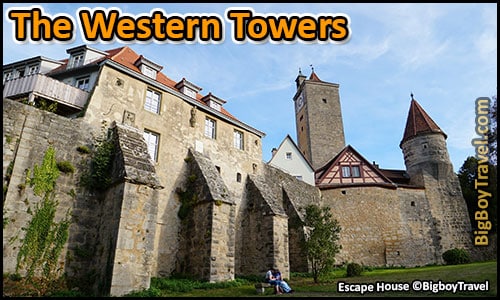
About The Western Towers : The area just outside the Western edge of Rothenburg’s city wall is an excellent tourist-free place to explore. There are 4 different towers and a series of stately mansions built right into the fortification on this stretch of the Rothenburg city wall walking tour. The views of the Tauber Valley and Toppler’s Water Palace below you are also very nice from this area.
Our favorite of these towers is the square-shaped Gravedigger’s Tower ( Totengräbersturm ) which nicknamed after the gravedigger Beadie who lived here and in the neighboring cottage at the turn of the 14th century. It may be the most boring looking of the four Western towers but there is something about it being the gravediggers home that makes it interesting. In Medieval times the town Executioner and the Gravedigger were looked down on as lower members of society . Because the public was also superstitious, members of these professions weren’t allowed to live with the general population and had to live in their respective towers.
The prettiest of the towers in this section is right as you leave the Castle Garden called the Burgeck. Not only is this fairytale tower attached to the Toppler Theater, but it is also next to the famous Escape House. During the Peasants Revolt in 1525, one of the people set to be executed was a doctor who escaped out the window and down the wall.
Further along the wall, you will find the round Convent Tower ( Klosterturm ) which was built in 1408. Not only does this tower have direct access back into town through the wall, but it sits right next to a popular playground for childer. As you reach the Northwestern corner of the City Wall you come to the Punishment Tower ( Strafturm ) which was used to jail and punish people with light criminal offenses. It’s too bad that this tower from 1410 was used for punishment as it is the most romantic-looking on the Western part of the wall. As the Northern edge of the wall curves around town you also get to walk through an excellent section of Rothenburg’s old Medieval moat.
22. Saint Wolfgang Church ( Wolfgangskirche ):
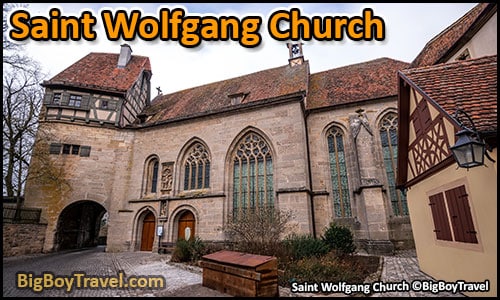
About Saint Wolfgang Church : When tourists make it all the way to the Saint Wolfgang Church they usually climb up on the city wall below the 99-foot-tall Narrow Gorge Tower ( Kilengentor ) and complete miss seeing the church. The fortified church was incorporated right into the city wall and has an exhibit about sheep and wool trade.
Saint Wolfgang Church also helps to put on the annual Shepherds’ Dance ( Schäfertanz ) that pays homage to Rothenburg’s days as a wool trading center and when the local Shepards’ Guild gained rights to a public feast in 1517. The coolest thing at the church is a rare chance to actually go inside Rothenburg’s city wall and descend down into the fortifications in the basement. It is definitely a different perspective than you get walking on top of the wall.
Shepherd’s Dance Website : Here .
23. Narrow Gorge Tower ( Kilengentor ):
About Narrow Gorge Tower : Drops steeply to the Tauber River which is why it has the name Narrow Gorge Tower which was built in the 1200s. Around the year 1500, the gate tower was raised to a 99-foot-tall watchtower which also served as a large water tower with a lantern hood top. Access for climbing up the Narrow Gorge Tower was directly from the attached church in Medieval times. Neighboring steps provide access onto the wall today.
24. Northern Wall Walk :
About The Northern Wall : The stretch of Rothenburg’s city wall from the Narrow Gorge Tower all the way to the Hangman’s Tower is the least crowded section to walk on even on busy tourist days. As you pass the old Gun Powder Tower and look out onto the red rooftops of town it can be very peaceful. The scenery here isn’t as grand as the other sections of the wall, but because you can often have it to yourself it really helps you enjoy the experience of walking along the wall itself.
Remember that it was this Northern part of Rothenburg that was badly damaged by bombings in WW2 requiring most of the area to be rebuilt. You will pass by open lots and parking areas which makes you appreciate that the core of the town was mainly left untouched during the war.
25. Gallows Tower & Dry Moat ( Galgentor ):
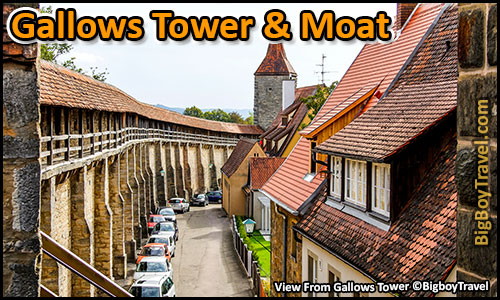
About The Gallows Tower : The Gallows Tower was built in 1388 in the largest expansion of the city wall but was burnt by fire in 1400. The tower was quickly repaired and sits at the highest point of the town fortification. There are square artillery posts along this wall section which once were as many as 12 as this was the weakest part of the city wall. To strengthen this Northern section of the wall they added 5 watchtowers in 1600, but General Tilly breached the wall at the neighboring Kummereck Tower in 1631 and the French did the same thing in 1645.
The city gallows stood outside the Gallows Tower in the Little-Head Meadow ( Kleine Kopfwiese ) and were used until the mid-1800s. This is also a great place to see the dry moat that rings the village. The dry moat between this tower and the Woodsman Tower & Gate ( Röderturm ) is where the Knights of 1274 tented camp are set up during Rothenburg’s Imperial City Days Festival every September.
26. White Tower & Jewish Quarter ( Weißerturm ):
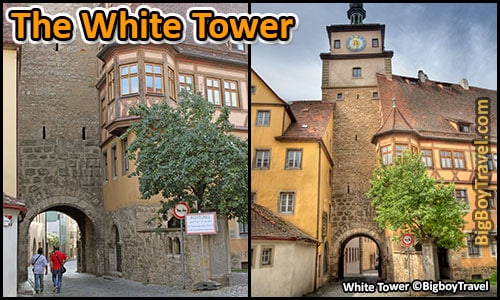
About The White Tower : The White Tower was built as part of the original city wall in the 1100s and is the oldest surviving along with Marks Tower. Next to the tower was the Jewish Community Center ( used from 1390 to 1520 ) and you can see memorial Jewish grave markers below the tower. The original headstones from these graves are on display inside the Imperial City Museum.
Jewish Lane ( Judengasse ) branches out from the tower and is considered the only surviving late-Medieval Jewish street in Europe. The road formed around the curve of the wall after the Jewish residents of Rothenburg were banished outside of the city walls in 1298. This is the same year that 500 members of the community were burned alive inside part of Rothenburg’s vacant castle by a traveling mob. The local Jewish community faced further hardships when they were completely expelled from Rothenburg in 1521.
The Seal Fountain ( Seelbrunnen ) in the Jewish Quarter is capped by Minerva, the Roman Goddess of Wisdom built around 1600. She is holding the seal of Rothenburg as she is the patron of the city and a mirror because she is said to be able to look inside your soul.

Other Nearby Sights:
27. old town walking tour :.
About Old Town Rothenburg : The tightly packed city center of Old Town Rothenburg is filled with Medieval lanes, half-timber houses, amazing shopping, and grand buildings you just have to see.
Read More : Old Town Rothenburg Walking Tour .
28. Mayor Toppler’s House :
About Mayor Toppler’s House : Little moated palace was built in 1388 by legendary mayor Heinrich Toppler. Has an awesome tower. Is open to the public. Built partly as a defensive tower, partly as a residence in 1388, this moated castle once belonged to the powerful Lord Mayor Heinrich Toppler. Now it is filled with furniture from the 16th to the 19th century.
Toppler House Hours : Interior is open April-October Friday-Sunday 1pm-4pm; the exterior is open year-round.
Featured Article

Sign Up For Our Newsletter For Free Travel Tips
Email Address *
Disclaimer: Information on this page and in our walking tours were deemed accurate when published, however, details such as opening hours, rates, transportation, visa requirements, and safety can change without notice. Please check with any destinations directly before traveling.

Rothenburg Night Watchman Tour: The Best City Walking Tour Ever?

I will tell you this: I’ve been on my fair share of city walking tours in Europe. Actually, I’ve been on them everywhere.
My all-time favorite is the Rothenburg ob der Tauber Night Watchman tour .
I mean, I’ll update you if this ever changes, but I kind of doubt it. This tour is the bomb.
On this tour the Night Watchman will take you to all the central Rothenburg ob der Tauber sights, and teach you all about the city’s most important (and some lesser-known) history. I simply can’t recommend this delightful, affordable experience enough.
Keep reading for everything you need to know about the Rothenburg Night Watchman tour!

Who is the Rothenburg ob der Tauber Night Watchman?
The Night Watchman is a German guy with excellent English speaking and storytelling skills, who will teach you all about the rich history of Rothenburg ob der Tauber.
He does this whole educational, entertaining tour from the perspective of a Medieval times city night watchman! These guys patrolled the gates of a city back in the day, and knew the goings-on and city secrets better than anyone. Plus, his costume is excellent.
I don’t know how long the Night Watchman has been giving his dusk walking tour of Rothenburg, but judging from a quick Google search it looks like the answer is: a while .
And it shows! He was one of the best historic re-enactors and tour guides I’ve ever seen. I worked in the National Park Service, which required me to do very similar things (explain complex topics to wide-ranging audiences in a fun, animated way, though my costume was a little less crazy).
I know a good story-teller when I see one, because I’ve been trained in story-telling. This guy could be a Park Ranger any damn day of the week.

Feel like popping over to Austria next? Check out my guide to a perfect day in Salzburg !
How much does the Rothenburg Ob Der Tauber Night Watchman tour cost?
Perhaps the best part of this incredible tour is the reasonable price.
Adults: 8 Euro
Teens: 4 Euro
Kids under 12: Free!
Honestly, I would’ve tipped that much anyway because the tour is so excellent, so it’s truly a bargain. I know you might be used to free walking tours, like those offered through hostels and such, but this guy does this for a living . And he’s stellar. He could’ve charged twice as much and I would still say it’s worth it!
You pay at the end of the tour, which is quite the honor system considering how many people are on a tour. He’ll give you change if you don’t have exact.
Like fairytale cities? Check out my 4 day Prague itinerary 😉
Is the tour appropriate for children?
Absolutely!
There were a ton of kids on the tour when I went, and as long as they aren’t disruptive it’s totally fine. In fact, it looked like the Night Watchman enjoyed interacting with them!
The tour accomplishes something quite rare in historical education, in that I think it was truly accessible to everyone. It doesn’t pander to the audience, either, which I appreciate. I am wary of people in costume=cheesy tours, but this wasn’t the case in my opinion.
Also, while we’re on the subject of age, there’s not too much walking on this tour for folks of all ages. There were young kids and older grandparents alike—everyone seemed to love it!
How does one join the Rothenburg Night Watchman tour?

You don’t need to sign up in advance or anything for the Rothenburg Night Watchman tour. Simply show up at Market Square in front of the Town Hall at 8:00 PM. From March to January, this is true every single night .
From the months of January to March there are limited hours; just Saturday tours. Again, it’s at 8:00 PM at the Town Hall!
Chances are, you’ll know just where to wait based on the massive crowd. Apparently the Night Watchman has had tours of 300 people! Yikes. I imagine that is during holiday weekends and such, because my tour was much smaller.
You’ll know the tour is starting when a man dressed as a Medieval Night Watchman, cape and all, strolls up with his torch and starts addressing the crowd. Pretty straightforward situation there.
What does the Rothenburg Night Watchman tour include? How long is it?
The tour is an hour long , and it goes by remarkably quickly.
The tour starts at the Market Square Town Hall and meanders through the streets, in and out of the gates of Rothenburg.
The Watchman will stop at various points of interest, like the aforementioned Medieval city gates, and give little talks and tell stories about their significance.
You’ll see several interesting historical spots and learn a lot about the city on this tour. If you arrive in Rothenburg later in the day, the Night Watchman tour would therefor be a great first stop. It puts much of Rothenburg ob der Tauber in historical context, which enriches the experience of exploring it on your own the next day!

Heading into the Mediterranean? Check out my 10 day Italy itinerary !
Why should I go on the tour?
If I haven’t convinced you already, I’m not sure what else I can say… other than, this is one of the best activities in Rothenburg Ob Der Tauber. It really made my trip memorable.
Going on this tour also gives you the chance to do something I desperately, aggressively recommend you do: spend the night in Rothenburg. It’s a hotspot for day trippers, as the midday crowds leave no question of.
My favorite moments in Rothenburg ob der Tauber were in the evening and morning, when I felt a calm descend over the city.
The Night Watchman takes full advantage of this quiet calmness, and he makes you feel as if you could be walking around Rothenburg hundreds of years ago. It really makes you experience the city in a unique way!

Like it? Pin it!
*This post contains affiliate links, meaning if you purchase anything through them I receive a small commission at no cost to you!*
Recent Posts
Osprey Kyte 46 vs Gregory Amber 44: Battle of the Best Carry-On Travel Backpacks
K-beauty from seoul: missha bee pollen renew ampouler, treatment, and cream review, you may also like, 7 days in ireland itinerary, 4 day prague itinerary, a guide to wwoofing in greece, 10 days in germany itinerary.
The “no pre-booking just show up” is the information all the other websites I’ve looked at were lacking! Thank you!
Hi Kaisa, we will be doing this tour in mid Sept. and we are looking forward to it. I was wondering, how can everyone hear him if there is such a big crowd? Does he wear a microphone? Is everyone crowding behind him and then would we miss what he is saying if we are not close to him? I am hoping the crowds won’t be bid when we are there. Thanks for your info, Diane
We took the Night Watchman’s (Hans Baumgartner’s) tour back in 2004. It truly was the best walking tour I’ve ever been on. And afterwards, Hans joined us for a bier.
Your comment goes here! Cancel reply
ROOTS ABROAD

The Ultimate 24 Hours in Rothenburg Ob Der Tauber Guide
Have you always wanted the chance to step back in time? Get a glimpse of life in a medieval town ? Then this Rothenburg ob der Tauber guide might be just perfect for you. Brightly colored half-timbered houses, charming narrow streets, and numerous watchtowers adorning the skyline. A place that looks like it came straight from a postcard. You will find plenty of idyllic spots worth photographing when wandering around.
We decided to visit this romantic town on our way from Belgium to Germany , the perfect stop-over. As a big Instagram hotspot, we came across the name multiple times online. So we decided to check what all the fuss is about. All we can tell you: is it’s definitely worthy of the hype. Honestly, we are not sure yet what impressed us the most. Is it the gorgeous medieval architecture, the cute little lanes, or the breathtaking view over the city from the Burggarten? Overall we felt like on a real-life movie set of a fairytale.
In this Rothenburg ob der Tauber guide, we will take you on our tour through the town. This guide lists all the must-see sights and landmarks, as well as our personal recommendations for restaurants & cafés. You can definitely explore this place within one day, but we really suggest that you consider spending a night. The perfect moment to experience the place in all its serenity is during the early morning and the evening. The big hoards of tourists have left and a magical calmness falls over the city.
* Disclosure: This post contains affiliate links. We will receive a small commission if you book through our links. This is at no extra cost to you. This way you’re helping us write awesome travel guides and keep providing you with free content. We only recommend products we like and trust ourselves.
The Medieval charm of Rothenburg Ob Der Tauber
This tiny wall-encircled town is located in the southern part of Germany along the “Romantic Road” . It is a must-see destination when traveling to the country, so put it on your travel bucket list. Not surprisingly, the picturesque destination is a popular spot for road trippers. Bigger cities such as Munich and Frankfurt offer all kinds of organized day trips (read more: how to get there ).
The Bavarian hotspot is one of the best-preserved medieval towns in Europe , although it suffered a lot in the past from war and natural disasters. The majority of the wall and its towers still look to date as they did back in the 16th century. Nowadays it’s a beloved tourist attraction and served as an inspiration for many fairytale movies and stories.
The name “ Rothenburg ob der Tauber ” literally means ”Red fortress above the Tauber”. This comes from the fact that the town lies above the river Tauber which flows beneath. When you intend to visit this lovely town, make sure to navigate to “Ob der Tauber”. There is more than just 1 Rothenburg in Germany, so you won’t end up in the wrong place.
Join a tour of the old town of Rothenburg
Immerse yourself in the enchanting Old Town of Rothenburg ob der Tauber with a personalized and relaxed private walking tour led by a knowledgeable local guide. Discover the city’s rich history, culture, and traditions as you explore important landmarks such as the town hall, market square with the Council Drinking House, and the George Fountain. Customize your experience based on your interests, whether it’s strolling along the city walls and visiting historic gates, delving into the main churches like Jakobskirche or Wolfgangskirche, or learning about the region’s beer and wine culture and culinary specialties.
Rothenburg Ob Der Tauber guide | Sights & activities
The charming old town itself is undoubtedly the main attraction itself. Take your time strolling through all the small streets and going up the city walls to best experience the place. Also, keep your eyes open for all the beautiful iron signs that hang on the sides of many buildings. These so-called Zunftzeichen or guild signs were used to symbolize the profession and purpose of a building. Nowadays these usually mark the name of hotels, but still, add to the medieval atmosphere of the town.
Rothenburg often goes by the name “City of Towers”, which will become quite clear as soon as you approach the city. After we found our parking lot south of the city, just outside of the city walls (read more down below about how to get there ), we started our journey.
The city is super easy to get around on foot, and you can easily see everything in one day. However, if you would like to enjoy everything at a slower pace, maybe sipping a nice Bavarian beer at the end of the day on one of the many cozy terraces, we suggest you book a night at one of the many charming hotels within the Old Town . This way you can explore medieval architecture during the evening and wander the empty cobbled streets by night.
*Click on the above map to open and save an interactive Google Map of Rothenburg ob der Tauber, with locations for all the mentioned sights & activities, restaurants, and accommodations mentioned in this guide.
Spitalhof and Spitaltor
Your adventure in the Old Town will probably start at one of the six gates. As an imperial city during Medieval times, the citizens were protected by 46 defensive towers and a four-kilometer-long wall . These you can still explore today and we really recommend planning it as a 2-hour activity. If you start your journey in the south, you will enter through the Spital Gate bastion . This is the most recent part of the fortification and only was completed in 1537. Before passing through make sure to enter the bridge on the left side which leads you into the Spitalhof. Here you can wander through the halls that were once home to knights, keeping watch over the walls.
Walking down the former knight’s pit, you can proceed along the city walls until you pass by the Stöberleinsbühne and Stoeberlein Tower. Get back on the main road from here, which is called the Spitalgasse . This street will lead you to the famous Siebersturm, which looks picture-perfect on both sides. Once you pass through, you will find yourself in the most popular location in the town.
The Plönlein must be the most iconic landmark of all Rothenburg ob der Tauber. Known for this yellow half-timbered building in the center, in front of a small fountain. On each side, it’s framed by a stunning medieval watchtower. The road that goes down passes you through the Kobolzeller tower on your way to the Tauber River Valley. The other tower is the one we just passed, the most photographed Sieber tower. It leads you back to the Spital quarter or former infirmary quarter of the town.
Moving onwards on the Schmiedgasse , you will pass by several cute boutiques displaying all kinds of handicrafts and local specialties . Don’t forget to look up to see the colorful architecture and beautiful details of the houses.
Medieval crime museum
On your left, on the Schmiedgasse, you will pass the Medieval crime museum (Mittelalterliches Kriminalmuseum). This museum covers over 1000 years of Medieval law history. The self-guided tour takes you over 3 floors in the former monastery building, starting in the basement. There you can find several original instruments of torture that were used to punish people. Punishment was given for all kinds of crimes, from stealing to cheating spouses. On the other floors, you can see what was persecuted in medieval times, such as witches and the use of magic.
OPENING HOURS & ONLINE BOOKING TICKETS FOR THE MEDIEVAL CRIME MUSEUM
Wander the Marktplatz and hike up the Rathaus tower
At the end of this street, you will end up at the heart of the town, the market square (Marktplatz) . As you will notice, this is one of the most lively areas during the summer. The perfect spot to take a break is at one of the cafés. Here you will encounter many groups of tourists that are admiring the beautiful architectural details this square has to offer. The imposing 13th-century Town Hall ( Rathaus ) dominates the square. On the opposite side, you have the former Council Tavern ( Ratstrinkstube ). As the centerpiece, there is the Georgsbrunnen (fountain) that sticks out beautifully against the red and blue half-timbered houses.
TIP | For just 2,50 € you can visit the Town Hall’s tower. It gives you a magnificent 360-degree panoramic view of the old town after climbing up 222 steps. The tower played a significant role in the Middle Ages in the city’s defense strategies and communication with the other watchtowers.
TOWN HALL TOWER OPENING HOURS | January-March & November: only on Saturday & Sunday from noon till 3 pm. April-October Daily from 9:30 am-12:30 pm & 1-5 pm. During Christmas time daily from 10:30 am-2 pm & 2-6 pm (Friday & Saturday until 7 pm).
Enjoy the Christmas spirit at the German Christmas Museum
Rothenburg ob der Tauber is one of Germany’s most beloved destinations to enjoy the Christmas markets . At the German Christmas Museum ( Deutsches Weihnachtsmuseum ) you can even experience the traditions all year round. Here, you can learn more about local traditions and Germany’s Christmas history. Moving forward on the Herrngasse you will also pass by the Kathe Wohlfahrt Shop . The shop is easy to spot with its Christmas delivery truck, topped with a pile of gifts. The perfect stop for all Christmas lovers to stock up on new decorations and ornaments since it has the largest ornament collection in Germany.
➤ READ MORE | The Most Magical Christmas Markets in Germany
Marvel at the St. Jakobskirche
Strolling a bit more north from the Town Hall you will pass the gothic St. James’s Church (St. Jakobskirche), one of Germany’s most famous pilgrimage churches. The historic landmark was completed in 1485 and showcases some beautiful religious pieces inside. Via a staircase, you can admire the famous Altarpiece of the Holy Blood , a wooden carving of the Last Supper.
In the east choir, you will find an impressive 700-year-old stained glass window . The glass piece depicts scenes from the Passion and the Life of Mary. It lets an amazing light in especially in the morning sun, creating a colorful hue. The outside of the church is characterized by two tall spires adorned with crockets. They really dominate the town’s skyline from everywhere you look. An imposing building, really worth a visit on the inside.
Walk the Old City Wall: Rothenburg’s Tower Trail
From the St. James Church, we proceeded our journey more north towards the Klingentor . Here we decided to go up on the wall to start the walking tour. There are many entry points around the city to start your City Wall walking tour . Access is possible throughout the whole day and it’s FREE . You can start at the main gates: Spitaltor, Klingentor, Galgentor, Rödertor, Burgtor, or Kobolzeller Tor. In total, there are 42 gatehouses and towers, so you can spend quite some time being up here. We would suggest planning in approximately 2 hours since the full route is around four kilometers.
TIP | You can get an information brochure “Turmweg Rothenburg” of the tour at the tourist information office on the market square.
We decided to go up on the wall around sunset, the perfect time to enjoy a peaceful walking tour. The setting sun gave a beautiful golden-hour light over the pastel half-timbered houses. These walls are one of the best-preserved medieval walls all over Germany. Some parts even date back to the 13th and 14th centuries. Other parts however were heavily damaged or destroyed during WW2 but have been rebuilt afterward. Walking here you will get a perfect bird’s eye view of the best parts of the cities.
Treasures along the Tower Trail
Along the way, you will pass by other sights such as the adorable Blacksmith Shop ( Gerlachschmiede ). One other worthwhile stop on the Tower Trail is at the Rödertor. The tower is located at the southeastern entrance of the old town and used to serve as a signaling post. Next to the town hall, it’s the only watchtower in Rothenburg ob der Tauber that you can climb up. (Admission fee is €1,50, only open on weekend afternoons).
We decided to end our Tower Walk near the Markusturm . In our opinion, one of the most photogenic towers in the city. The surroundings here are just absolutely stunning, mostly the view of the flower-filled Roeder Fountain . From here we took our time to wander through the cute little alleyways, which are just full of medieval charm. Pick up a souvenir in the many boutiques or take time to sit down on one of the many terraces.
Discover Rothenburg with a Scavenger Hunt
Unleash the adventurer within and explore Rothenburg ob der Tauber with an exciting scavenger hunt game and audio guide app. Download the app to your phone and assemble your friends or family in the heart of the city. Embark on a journey to uncover the city’s top sights. At your own pace, solve puzzles and complete thrilling assignments while immersing yourself in the rich history and present-day culture of Rothenburg. This dynamic and engaging experience will leave you with unforgettable memories and a deeper understanding of this captivating city.
Escape to the castle gardens
The Castle Gardens (Burggarten) are the ideal place to take a breather from the heat and the tourist crowds. The garden is beautifully designed with flowerbeds and enough benches to relax in the shade. You will also stumble upon eight sandstone sculptures that represent the four seasons and the four elements. The garden gives you a wonderful view of the old town . When you look down you will also be able to see the Taubertal (Tauber Valley) with its double bridges. The perfect spot to watch the sunset!
“Fun” fact: unlike the name suggests, there is no castle to be found next to the castle garden anymore. The castle was destroyed during an earthquake in the 14th century. Don’t forget to look up to the Burg Gate (Burg Tor) when leaving the castle gardens. There you will see a big mask on the side which was used to pour hot tar onto attackers. Inside the gate is a small door, known as the ‘Eye of the Needle’. This was the only way people were allowed to leave at night with permission from the Town Council.
Discover Rothenburg by night with the Night Watchman’s Tour
For a true medieval experience, join the Night Watchman’s night tour and travel back in time. During this one-hour tour, a costumed guide with a black cape and lantern will take you on a stroll through the town while telling you old tales about Medieval life. Walk along quiet squares and dimly lit lanes, immersed in the city’s unique atmosphere. Listen to the entertaining and informative stories of the night watchman as he unveils the secrets of the Middle Ages, including tales of the Black Death, torture, and city defense. Only for this tour, it’s already worth staying overnight for a day.
Rothenburg Ob Der Tauber guide | Regional specialties & handicrafts
We personally always love to discover local handicrafts and try out regional specialties . Rothenburg is full of cute little shops, so don’t expect to be leaving home empty-handed. You will always be able to find some kind of souvenir for each family member.
Christmas ornaments & lighthouses
The town is the ultimate Christmas destination , so perfect if you want to stock up on new Christmas decorations. Make sure to stop by Käthe Wohlfahrt Christmas store for new tree ornaments and decorations. Other beautiful Christmas pieces are available at Leyk Lichthäuser , a small family business that makes handmade ceramic lighthouses. Leyk has been a manufacturer in Rothenburg for centuries. Other typical souvenirs to take include wooden art carvings, wine glasses, and beer steins. We are in Bavaria after all ;).
Schneeballen & traditional candy
More on the hunt for something edible? All over town, you will bump into these bakeries selling Schneeballen or Snowballs , a Rothenburg pastry specialty. It’s a round-shaped deep-fried doughy ball dipped in frosting, chocolate, or sugar (up to you). We always advise you to try things for yourself, but this one wasn’t really one of our favorites. The flavor mostly comes from the outside topping and the inside is rather dry and flavorless. Originally the Schneeball came into existence because bakeries didn’t want to throw away left-over dough. So they decided to put these together as a dessert snack.
When you are a true sweet tooth, we can recommend stopping by the Bonbonmanufaktur . This is a traditional candy factory that still handmakes its candies according to old traditions. Delicious & colorful, without unnecessary additives!
Rothenburg Ob Der Tauber Guide | Where to eat?
There is definitely no shortage of cozy restaurants in Rothenburg ob der Tauber which made it hard to pick one during our stay. So we tried to shorten the options with our recommendations below, depending on what you are searching for.
Cozy coffee breaks
Enjoy a breakfast or coffee break at Cafe Einzigartig , a vintage-looking café filled with arts and antiques. A lot of the pieces are even available for purchase. This place serves a range of both delicious and healthy options, as well as desserts. Although it’s located in a more peaceful part of town, it’s a beloved spot among visitors. So make sure to reserve a table up front.
For a break during all the exploring, make a stop at Landsknechtstubchen . We had the best flammkuchen paired with an amazing Riesling wine here. Another cozy option for some refreshment is the Weinstube Zum Pulverer , which you can find on your way to the Burg Garten. Perfect spot to enjoy a cold drink on a hot summer day. Visiting on colder days? The inside has that perfect authentic German charm to it. Here you can savor a good traditional meal on those old-school wooden tables. Like everywhere in Bavaria, the portions are quite large, so there is really no need for appetizers if you still fancy a dessert.
Franconian cuisine for dinner
For dinner, there are plenty of traditional Franconian Bavarian places to find in the old town of Rothenburg. Franconian cuisine is mostly known for warm-hearted dishes. Think of goulash, bratwurst, or steak with a side of homemade knödels or Käsespätzle.
We had some super delicious dishes at the Alter Keller . If you are looking for that typical Bavarian food, then this is the place for you. Another place in the same style that we read good reviews about is Zur Hoell . Looking for a more international option? Am Platzl has a more modern take on traditional food and offers a menu with Italian & Asian-inspired dishes.
Rothenburg Ob Der Tauber Guide | Where to stay?
Most of the sights are right within the old town’s walls, alongside many of the hotels. To truly immerse yourself in the captivating magic of Rothenburg ob der Tauber, we highly recommend booking a stay within these historic walls. Whenever would you have the opportunity again to stay overnight in a medieval town? If you have your heart set on a specific stay, make sure to book a bit upfront!
OUR STAY | Hotel Uhl
We booked our stay at Hotel Uhl , located right between the Siebersturm and the Plönlein. A magnificent view to wake up to, straight out of a fairytale. Spending the night in one of those typical old houses was an amazing experience. Although the hotel is in one of those old charming buildings, the room was very spacious. Breakfast was absolutely excellent at Hotel Uhl. They served a wide range of plates at the table with the possibility to order eggs & coffee to your liking.
BUDGET | Hotel Eisenhut
Experience the authentic old-world charm of Rothenburg ob der Tauber at Hotel Eisenhut . While the building exudes historical allure, the rooms have been modernized. Situated near the Marktplatz and close to the Christmas Museum, this hotel is ideally located for exploring the city’s treasures. Enjoy free WiFi, a beautiful garden, and a terrace to unwind. For added comfort, private parking is available at an extra charge. Savor a delightful buffet or continental breakfast before embarking on your adventures. Additionally, indulge in a culinary journey with a restaurant on-site offering French, Pizza, and German cuisine.
BUDGET | Historik Hotel Gotisches Haus garni
Housed in a restored 13th-century building, the charming Historik Hotel Gotisches Haus Garni immerses you in a true Gothic-style ambiance. The rooms exude character and romance, offering stunning views of the medieval town. Antique marble bathrooms with corner bathtubs add to the enchanting atmosphere. Begin your days with a delightful complimentary breakfast buffet and relish coffee and cake in the cozy library throughout the day. Conveniently located near the marketplace, this hotel serves as an ideal base for exploring the picturesque town of Rothenburg.
MID-RANGE | Klosterstüble
Klosterstüble is a charming and romantic hotel housed in historic buildings dating back to the 16th century. The traditionally furnished rooms boast typical wooden beams, adding to the authentic ambiance. Each room is elegantly styled with a private bathroom for a romantic stay. Guests can start their day with a hearty buffet breakfast and indulge in traditional Franconian dishes at the hotel’s welcoming restaurant. During good weather, drinks can be savored on the inviting terrace
LUXURY | Hotel Herrnschloesschen
Indulge in a luxurious experience at Hotel Herrnschloesschen in Rothenburg ob der Tauber. Situated near Burg Garten and across from the monastery, this hotel resides in one of the city’s oldest buildings, surrounded by a picturesque baroque garden. The hotel boasts a restaurant, offering delectable dining options. Guests can enjoy the convenience of free internet in all rooms and complimentary drinks from the minibar. For relaxation, the hotel provides a sauna located in its historic cellar. Explore nearby medieval attractions and the Tauber Valley with the hotel’s rental bicycles, and for guests arriving by car, private parking is available.
MODERN | Villa Mittermeier
For those seeking modern decor, Villa Mittermeier in the newer part of Rothenburg ob der Tauber is an excellent choice. Nestled within a charming villa directly at the Galgentor, this hotel offers a unique and historic ambiance. The spacious rooms are individually designed and feature amenities like a desk, TV, telephone, and en-suite bathrooms with a hairdryer. Guests can enjoy free Wi-Fi throughout the property, complimentary parking spaces, and attentive service, making their stay a comfortable and memorable one.
SPEND A NIGHT | See all hotels on booking.com and spend the night in Rothenburg ob der Tauber
Rothenburg Ob Der Tauber Guide | How to get there?
Rothenburg ob der Tauber must be the top sight on Germany ’s Romantic road tour and is fairly easy to reach from the bigger surrounding cities. Transportation to the medieval town is possible by (rental) car, public transportation (bus and train) as well as day-trip bus tours coming from Munich (München) and Frankfurt am Main.
When you’re exploring Germany by (rental) car , it will take you around 2,5 hours on the highway coming from Munich city. Nuremberg is closer, with 1 hour away, and Frankfurt is around 2 hours by car. You will find 5 parking lots outside the city walls , each located close to one of the entrance towers. We parked at parking lot P1 Friedrich-Hörner-Weg , located south of the city, where a day ticket only costs €5,50. Parking is free from 6 pm until 9 pm if you would decide to spend the night.
The other option might be taking the train , however, it’s a little less convenient since the journey will take more time (up to 3 hours from Frankfurt, 2,5 hours from Munich, and 1,5 hours from Nuremberg) and you might have to change trains twice. The prices of train tickets start at €17,90 one-way for a standard class ticket if you book in advance. Bear in mind that booking on the same day can get more expensive since prices can vary depending on the time, route, and class. Once you arrive at Rothenburg ob der Tauber, It’s only a 10-minute walk from the train station to the old town center.
TAKE THE TRAIN | Book your ticket for Rothenburg ob der Tauber online
Day trip tours
You can also opt to join an organized tour if you would like to do a day trip from a surrounding city. There are often several kinds available from Munich or Frankfurt. You can for example find a whole day trip from Munich here , where they will take you along the Romantic Road and the most historic sights. This particular tour also makes a stop at Harburg Castle, one of the oldest fortifications in Germany dating back to the 11th century.
DAY TRIPS | Book a day trip tour to Rothenburg ob der Tauber online from other cities such as Frankfurt, Nuremberg, Würzburg, or Munich.
We hope this Rothenburg ob der Tauber Guide helped you out. You can show some ❤ and support for the blog and help us share more adventures! Our travels are entirely self-funded, so any show of support is greatly appreciated. It allows us to keep writing helpful travel guides and gather information to make it easier for people to discover the world.
No time to read now? Pin it to Pinterest for later!

Best Things to Do in Nuremberg | A Complete 2-Day Guide

The Most Magical Christmas Markets in Germany (UPDATED 2024)
Leave a comment cancel reply.
Your email address will not be published. Required fields are marked *
Save my name, email, and website in this browser for the next time I comment.
Walking on the Free Ramparts and Town Walls of Rothenburg ob der Tauber
Walking on the sentry walk on the walls and ramparts of Rothenburg ob der Tauber is free and a top attraction when visiting the romantic, wall-enclosed medieval town.

Romantic Rothenburg ob der Tauber, at the heart of the Romantische Straße tourist route in Germany, is famous for its beautifully preserved picture-perfect medieval old town center that is still surrounded by its defensive town wall. It is possible to appreciate the ramparts from outside the town but it is more fun to follow the sentry walk on the wall for fantastic views of the old town center, half-timbered houses, and the beautiful countryside. Access to the sentry walk is free and most of the walls are open year-round and at all times. Day-trip tours are often available from Frankfurt and Munich.
Ramparts of Rothenburg ob der Tauber

The medieval town center of Rothenburg ob der Tauber is still completely encircled by its town walls with over 40 towers and town gates still in place. Much of the walls are original from 1400 with defenses strengthened until the mid-17th century — following the Thirty Years’ War (1618-48) Rothenburg was too impoverished to dismantle the walls or update the buildings of the town according to newer fashions.
Rothenburg’s chocolate-box, picture-perfect medieval look only became popular again with artists and then tourists from the mid-19th century. Currently, Rothenburg attracts well over 2 million visitors per year — it is by far the most popular stop on the Romantic Road tourist route.
It is possible to follow the sentry walk on the walls of Rothenburg around most of the town. The sentry walk is mostly covered making it also a pleasant walk in rainy weather. Most of the walls are open at all times and year-round.
Town Walls of Rothenburg
The just over 3 km (2 miles) of town walls encircling Rothenburg were built in three main phases:

Rothenburg received town rights in 1172, which allowed the settlement next to an older castle, to encircle itself with a defense wall. The original town was roughly in a circle shape with the steep slopes on the western part of the town forming a natural defense that was topped by further walls. The Weißer Turm (White Tower) and über-romantic Markusturm (Markus Tower) with the Röderbogen (Röder Arch) still mark the outer limit of the city in around 1200 — the total length of these first defensive walls was 1,400 m.
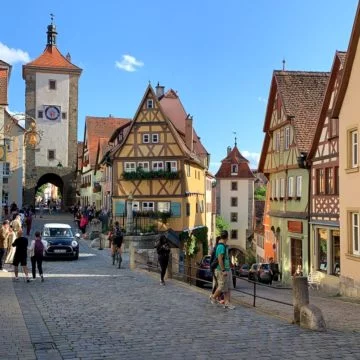
In the second phase — late 14th century — the defense walls were moved outwards with the new ring away from the valley to mostly where the walls are today — the walls were now 2,400 m. However, the southern limit was the Siebersturm (1385) just beyond the famous Plönlein square. At this stage in history, Rothenburg with a population of 6,000 was one of the ten largest cities in Germany. (Definitions differ but irrespective of the way of counting or the political geography, it was one of the richest and most important cities in medieval Germany.)
The third and final phase added the southern tip from beyond the Plönlein to the Spitalbastei. This impressive figure-8 bastion was still strengthened during the Thirty Years’ War when Rothenburg was occupied several times. By the mid-17th century, developments in military technology made town walls irrelevant and impoverished Rothenburg of little interest to attackers anyway. Then, as now, the total length of the wall amounted to 3,400 m (2.1 miles).
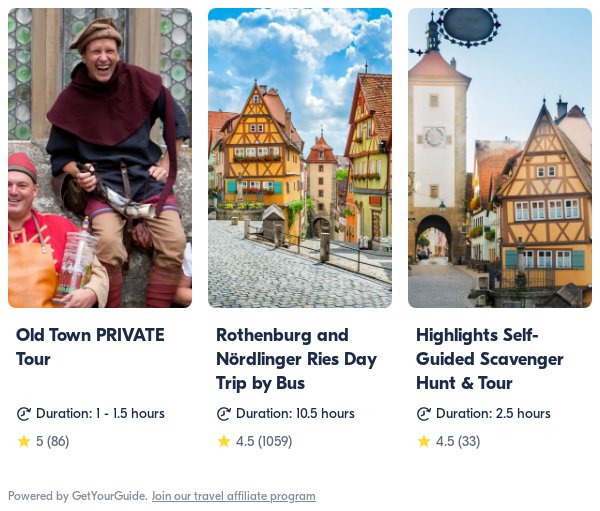
Access to the Walls of Rothenburg

Since the completion of the final building stage, the bird’s eye view shape of Rothenburg ob der Tauber could be described as a keyhole, or a face (with a pointy nose) seen in side profile. Using the image of a side profile, it is possible to walk from the neck along the back of the head to the forehead, not along the face, but again from the chin to the neck.
Using a map, it is possible to walk on the covered sentry walk all the way from the Spitalbastei (in the south) to the Klingenbastei (on the northwestern corner of the town) along the eastern and northern sides of the town (left and top on most maps).
The only significant parts of the walls of Rothenburg that are not accessible are on the west (left side of most maps) — from the Klingentor in the north to the Kobolzeller Tor (near the famous Plönlein) — and the small section at the south from Reichsstadthalle to the magnificent Spitalbastei.
Rothenburg’s Ramparts and Walls

The medieval defense structures of Rothenburg ob der Tauber are among the most popular attractions of the town. Of the around 70 defense towers in operation in Rothenburg at the time of the Thirty Years’ War, 42 are still maintained in some form. The only one that may be climbed is the Röderturm (small charge).
Most to the gates and towers display the shield with two red towers for Rothenburg while the black eagle on a yellow background is for the Holy Roman Empire to indicate visitors enter a Free Imperial City, which Rothenburg was from 1274 until it was absorbed by the Kingdom of Bavaria in 1802. (The double-headed eagle was only in use after 1433.)
Top Bastions and Town Gates in Rothenburg
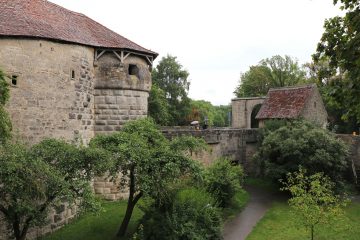
Four of Rothenburg’s town gates with gate towers remain in use for motorized traffic while several further smaller entrances in the walls are used by pedestrians:
The most impressive part of the town defenses of Rothenburg of der Tauber is the imposing Spitalbastei at the far southern tip of the town. This is the only town gate where the complete bastion survived mostly intact. The Spital Bastion has double courtyards in the form of a figure 8, seven gateways, and upper walkways with embrasures survived. The bastion may be explored freely — the inside is dark at the best of times so best explored before dusk. The interior is vast but the roof fairly low and the windows small by design (form follows function). It was designed so horses could drag up cannons and supplies to the defenders.

The Klingentor at the northern exit towards Detwang and Creglingen similarly has impressive fortifications but these did not survive as complete as the Spitalbastei. An interesting part of the Klingenbastei is the Wolfgangskirche (1475) where the church was built inside the bastion and part of the town defense system. A huge water tank in the Klingenturm (1400) was the water supply for Rothenburg for over three centuries until 1910

The Rödertor and Galgentor once had very mighty bastions, as these were at the side of Rothenburg which had no steep slopes or other natural defenses. During the Thirty Years’ War, Tilly breached the walls here in 1631 and the French in 1645. The gate towers here survived but not that much of the original defense structures — some of the forward gates at the Rödertor are still in place and worth exploring if unable to see the Spitalbastei or Klingentor. The Rödertor is the only defense tower that visitors may climb to the top (€2) but the Rathaus tower is more popular for aerial views.
The Galgentor is the only gate to Rothenburg open to drivers at busy times (and then only for those with hotel reservations or other permissions to drive into the old town center). Its real name is actually Würzburger Tor but as the gallows ( Galgen ) were nearby the impression they’ve left survived long after their use ceased in the mid-18th century. (When in Rothenburg visit the very interesting Medieval Crime Museum for more on this and other criminal and legal history.) For this reason, the street inside the town leading from the Galgentor is the Galgengasse (Gallows Alley) while the street outside the gate is still Vorm Würzburger Tor (“in front of the Würzburg Gate”).
Smaller Town Gates

Two further gates gave access to the town but they are no longer open to motorized traffic:
The Burgtor that gives access to the Burggarten — a park with beautiful views of the old town, ramparts, Tauber Valley, Doppelbrücke, and the Topplerschlösschen — was an important entrance to the town but is now cut off from motorized traffic links. Here it is still possible to see not only the mask through which pitch could be poured onto attackers but also the mid-16th-century postern gate (a small door inside the main door). This so-called eye-of-the-needle door was used to allow individuals into the town one-by-one at night to prevent a surprise attack. Such admittance after dark required advanced permission from the town council — anyone arriving after sunset slept outside the town.

A glance from the Burggarten , where the original castle was, to the Tauber River in the valley 80 m below explains why it is Rothenburg ob der Tauber (Rothenburg Above the Tauber) and not Rothenburg an der Tauber (on the Tauber) in a similar fashion as for example Frankfurt am Main is “on the Main” and Frankfurt an der Oder is “on the Oder River”.
The Kobolzeller Tor (1360) is less imposing but at the same time very interesting. The structures here are not as elaborated as at the other gates but it is possible to access the sentry walk here and see how the defenses worked — this smaller bastion had its own inner courtyard and four gates. The steep slope inside the courtyard made an attack difficult with defenses possible from the devil’s chancel above, as well as from the Kohlturm tower.
Also from here — just a few houses down from the crowded Plönlein — it is often very quiet and a pleasure to walk on the wall towards the southern part of the old town.
Where to Walk of the Ramparts in Rothenburg

While the Spitalbastei is clearly much more impressive than say the Galgentor, the difference for various sections of the wall is less pronounced. Simply walking along any section is fun and gives good views either of the old town center or the countryside, although the latter less impressive away from the river.
Best Rothenburg Town Wall Walk

However, if given a free choice, after photographing the popular Plönlein, or actually the Siebersturm behind it, instead of heading back uphill to the crowded Market area, or through the gate to the southern part of the town, take the smaller road downhill to the right toward the Kobolzeller Tor. Go up the stairs as soon as possible to see the defense structure of this gate from above and then continue along the sentry walk as far south as possible — the Stöberleinsturm just after the amphitheater. This tower is the only one in Rothenburg to have preserved its original medieval roof and four corner turrets.
This section of the wall is often very quiet and the ramparts are more interesting with several staircases in rapid succession to take the sentry walk down several levels. It offers great views of the valley but perhaps less so of the medieval city. Rather than heading into town from the amphitheater, continue alongside the wall and exit the town at the Sauturm (pig tower) and walk the short sections outside the wall to the impressive bulwark of Spitalbastei.
Sentry Walk from Spitalbastei to Klingentor

It is possible to walk on the sentry walk all the way from the Spitalbastei to the Klingentor – a total distance of 2.5 km all roof covered. Parts of the wall here were destroyed by aerial bombing on 31 March 1945 but restored to the original condition. The name plaques here are of donors that originally helped to finance the restoration and of major contributors helping with the upkeep — the going rate is around €1,200 per m per year.
From this stretch of the wall, the old town views are the most interesting — the view through the walls is not so much of the countryside than modern town and especially huge parking lots. The areas near the Rödertor and Klingentor are often busier due to the proximity to parking lots and bus stops, however, the town views from here are superb. The St-Jakobs-Kirche (St James) with the Holy Blood Altar by Tilman Riemenschneider is the dominant church towards the north of the town.
Most of the air raid damage was done in the Northern parts of Rothenburg. If walking on the northern walls between the Schrannenplatz parking area and the Galgentor this area is clearly less interesting, even if the wall is generally a lot quieter than around the Rödertor. A popular sight just south of the Rödertor is the Gerlachschmiede — a half-timbered house that functioned as the smith shop until the mid-1960s.
Walking Around Rothenburg ob der Tauber

It is of course also possible to walk around the outside of the walls of Rothenburg ob der Tauber. On the Tauber River side (west), it is even a highly recommended hike with beautiful views of the old town, ramparts, and the valley.

On the west side, the town walls are mostly without a sentry walk, as the natural slope allowed for the defense wall to be much lower on the town side. It is often possible to walk right next to the wall inside the town and peak through the holes.
However, it is more interesting to walk on the outside of the town walls from the Klingentor to the Burggarten — where the original 12th-century castle was located. The small Topplerschlösschen (1388) was the retreat of the famous Rothenburg medieval mayor Toppler — it is one of the most-famous little castles in Germany but best seen from a distance. (It is only open on special reservation.)
It is similarly a pleasant walk on the outside of the town from the Burggarten to the Kobolzeller Tor or even all the way to the Spitalbastei— these slopes are known as the Riviera and at times steep. Either follow the direct upper route or go down towards the Tauber River and the Doppelbrücke (Double Bridge) — a 14th-century bridge resembling a Roman viaduct that is still in use but not on the main road.
Hiking on the eastern side of the town gives good views of the ramparts including the dry moat — wet moats are more a Hollywood fantasy, only the odd small castles, such as wonderful Schloss Mespelbrunn on the road to Frankfurt, originally had a true wet moat. Much of this area is park-like but also contains several large parking lots — walking on the sentry walk inside the walls is far more pleasant.
Other Wall-Encircled Towns in Bavaria
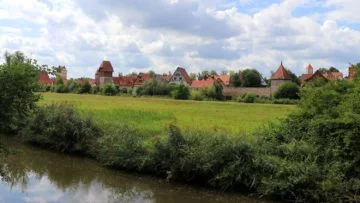
Rothenburg ob der Tauber is not the only wall-encircled town in Germany, it even has competition from several on the Romantic Road . At nearby Dinkelsbühl all the town defense towers survived to the present but here it is necessary to walk around the town rather than on the walls. In Nördlingen, which is famously nearly perfectly round, it is possible to walk all the way around the town on the restored town walls.
These two towns are very pleasant to visit too and are often pleasantly quiet, but Rothenburg remains the medieval jewel in the crown of the Romantic Road. As most visitors to Rothenburg are day-trippers, hotel prices are surprisingly reasonable, making it a good option to stay the night and enjoy the much quieter town in the evening and early morning.
More on Rothenburg ob der Tauber
For more on the Rothenburg ob der Tauber and nearby sights on the Romantic Road:
- Top Sights on the Romantische Straße with Romantic Road Map
- Walk on the Ramparts and Sentry Walk on the Wall of Rothenburg
- Visit the St.-Jakobs-Kirche (St James Church) with the Tilman Riemenschneider Holy Blood Altar
- Visit the Medieval Crime Museum
- Visit the Wolfgang’s Church in the Klingenbastei
- See the Herrgottskirche with Tilman Riemenschneider Altar of the Virgin in nearby Creglingen
- Transportation to Rothenburg ob der Tauber – Driving or Take the Train
- Bus Day-Trip Tours are often available from Frankfurt or Munich.
- Tripadvisor Hotel Comparison – Hotel prices in Rothenburg are surprisingly reasonable, except over weekends.
- Save with the Bayern-Ticket on Train Transportation in Bavaria
- Suntransfers give easy quotations for taxis and airport shuttles from Frankfurt or Munich airports.
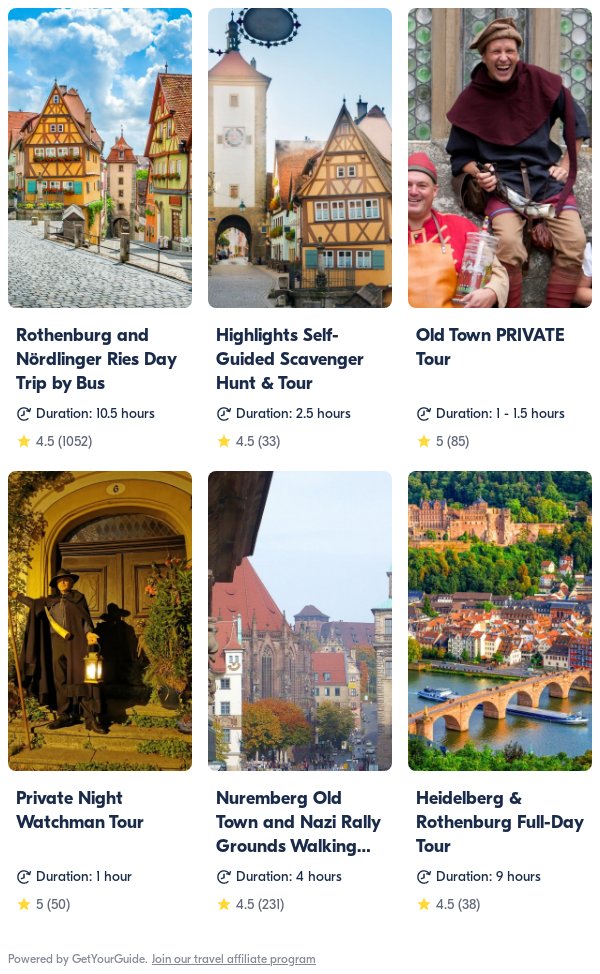
Home » Germany » Walking on the Free Ramparts and Town Walls of Rothenburg ob der Tauber
To provide the best experiences, we and our partners use technologies like cookies to store and/or access device information. Consenting to these technologies will allow us and our partners to process personal data such as browsing behavior or unique IDs on this site and show (non-) personalized ads. Not consenting or withdrawing consent, may adversely affect certain features and functions.
Click below to consent to the above or make granular choices. Your choices will be applied to this site only. You can change your settings at any time, including withdrawing your consent, by using the toggles on the Cookie Policy, or by clicking on the manage consent button at the bottom of the screen.
- jumpnav#jumpToSearchword"> Search function
- jumpnav#jumpToMainnav"> main menu
- Quick access
- jumpnav#jumpToMainContent"> Content

Guided Tours
Tours through rothenburg: entertaining and informative.
Discover Rothenburg on your own: certainly an exciting experience. You can find out even more about the city on the Tauber if you let our experienced tour guides guide and accompany you on your discovery tour.
They know a story or two to tell, know anecdotes and can give you tips that you won't find in any travel guide. And you can do what even the best current guide cannot do: answer your questions. Find out everything about the guest tours in Rothenburg.
We arrange interesting city and themed tours through the historic old town for individual travelers or as group tours. In addition, the original Rothenburg night watchman makes his rounds through the twilight (almost) every day.
We would be happy to provide you and your fellow travelers with tour guides to the Rothenburg area.
Travel groups can also book their individually booked city tour with our special group offers complete. Book your group tour directly here.
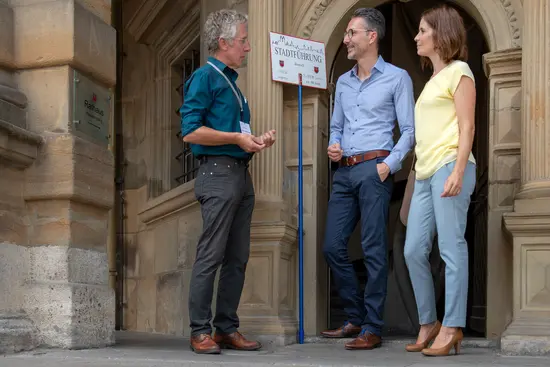
Public tours
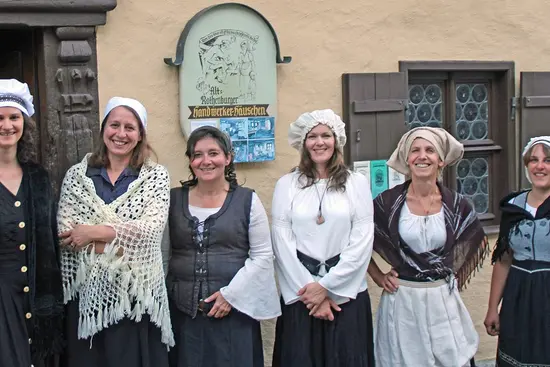
Group tours
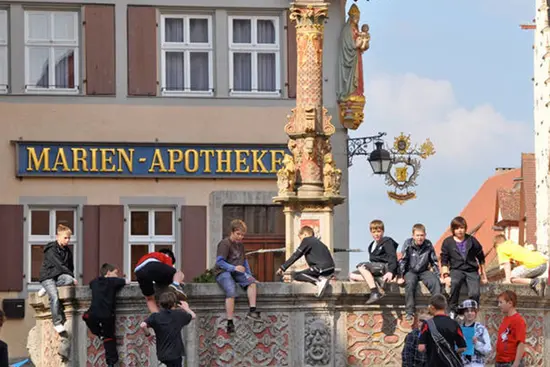
Student & youth groups

Group offers
We use cookies when they are strictly necessary for the operation of the website. For all other purposes and data transmission to external providers, we need your consent. You can revoke this here at any time. For more information see our Privacy policy .
- Video cookie-consent-overlay#revokeAllByType" data-cookie-consent-overlay-type-param="video"> deselect all Videos are embedded via external providers. Third-party cookies may be set when content is displayed. YouTube cookie-consent-overlay#toggleConsent" data-cookie-consent-overlay-cookie-name-param="communice_consent_video_youtube" data-cookie-consent-overlay-type-param="video" data-cookie-consent-overlay-sub-type-param="youtube"> Vimeo cookie-consent-overlay#toggleConsent" data-cookie-consent-overlay-cookie-name-param="communice_consent_video_vimeo" data-cookie-consent-overlay-type-param="video" data-cookie-consent-overlay-sub-type-param="vimeo">
- Map cookie-consent-overlay#toggleConsent" data-cookie-consent-overlay-cookie-name-param="communice_consent_openstreetmaps"> We use map material from OpenStreetMap to display an interactive map.
- Translation cookie-consent-overlay#toggleConsent" data-cookie-consent-overlay-cookie-name-param="communice_consent_gtranslate"> The translation function is provided via GTranslate.
- Statistics cookie-consent-overlay#toggleConsent" data-cookie-consent-overlay-cookie-name-param="communice_consent_matomo"> We use the web analysis tool Matomo for anonymous statistical evaluation. This information helps us to understand how visitors use our website.
- Other cookie-consent-overlay#revokeAllByType" data-cookie-consent-overlay-type-param="misc"> deselect all We have integrated additional services from external providers. Third-party cookies may be set when content is displayed.

De-Mail enables verifiable and confidential electronic communication. In addition, no one can hide behind a false identity with De-Mail, because only users with a verified identity can send and receive De-Mails.
If you would like to send us a De-Mail to the address given above, you need a De-Mail address yourself, which you can obtain from the state-approved De-Mail providers.
Information, explanations and answers to frequently asked questions can be found on the website www.de-mail.de of the Federal Ministry of the Interior, Building and Community. It provides information about your specific options for using De-Mail to communicate with companies and authorities www.de-mail.info .

12 Top-Rated Tourist Attractions in Rothenburg
Written by Bryan Dearsley Updated Dec 25, 2023 We may earn a commission from affiliate links ( )
Not only is it one of the best-preserved medieval towns in Europe, the old Bavarian Imperial City of Rothenburg ob der Tauber is also considered one of the most attractive towns in Germany . For these reasons, it's definitely one of the most popular stops on the country's Romantic Road tourist route.
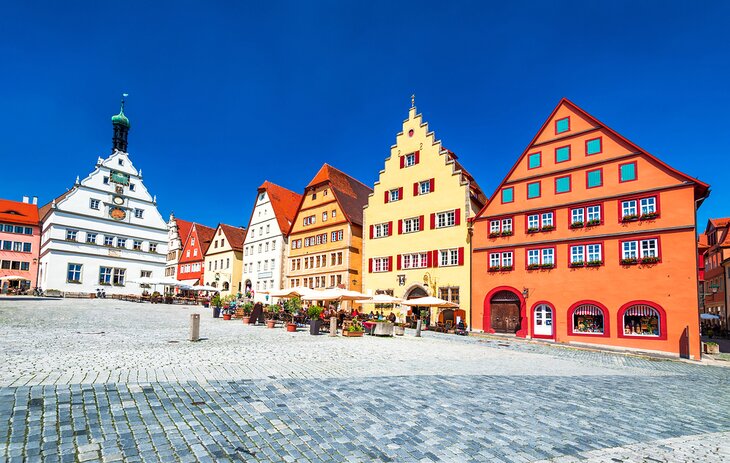
Picturesquely positioned on the steep banks of the River Tauber , Rothenburg's walls and towers look much as they did in the 16th century, while many of the buildings inside the walls are even older.
Among these fascinating points of interest are the 13th-century Town Hall (Rathaus); the 14th-century Council Tavern, with its old clock and mechanical figures; and several fine old churches. Half-timbered houses with their characteristic steeply pitched roofs line the narrow stone-paved streets, some housing museums that explore Rothenburg's long and fascinating history.
The chief attraction for tourists, though, is the charming old town itself, so spend some time strolling through it and walking along its walls.
To learn more about the best places to visit and other fun things to do in this historic German town, read through our list of the top attractions in Rothenburg.
See also: Where to Stay in Rothenburg
The Old Town (Alte Stadt)
Rothenburg town hall (rathaus), the old town walls, plönlein: the "little square", st. james's church, the castle garden (burggarten), medieval crime museum, german christmas museum, the master builder's house (baumeisterhaus), spitalhof and spitaltor, rothenburgmuseum, where to stay in rothenburg for sightseeing, tips and tours: how to make the most of your visit to rothenburg.
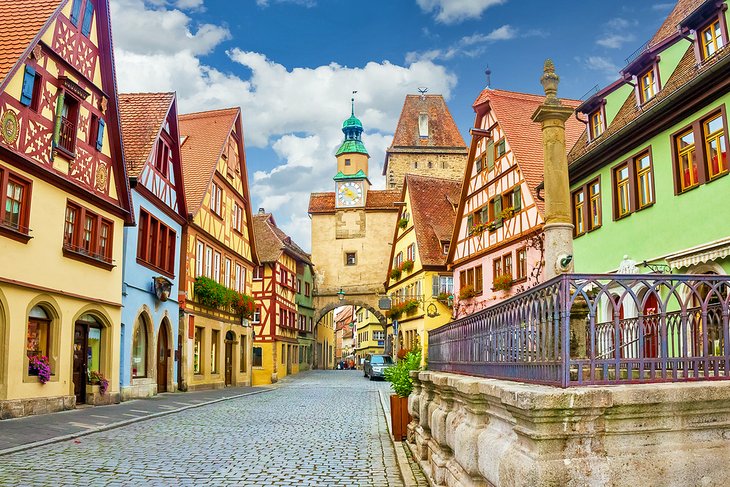
The charming streets and little squares surrounded by well-kept half-timbered houses have made Rothenburg the poster child for Germany's famed Romantic Road, and for Germany itself. So as you wander through the Old Town (Alte Stadt), its familiar scenes may make you feel as though you'd been here before.
In addition to the historic Town Hall (Rathaus), here, you'll find plenty of idyllic scenes worth photographing, including the sometimes brightly painted old half-timbered homes. If you visit in late November or in December you'll get to enjoy one of the best Christmas markets in Germany .
For a real treat, book one of the many hotels within walking distance of the Old Town and venture out at night. With the tourist hordes gone (most are only passing through on a day trip), you'll find yourself having much of this remarkable district to yourself.
Read More: Best Places to Visit in Germany in Winter
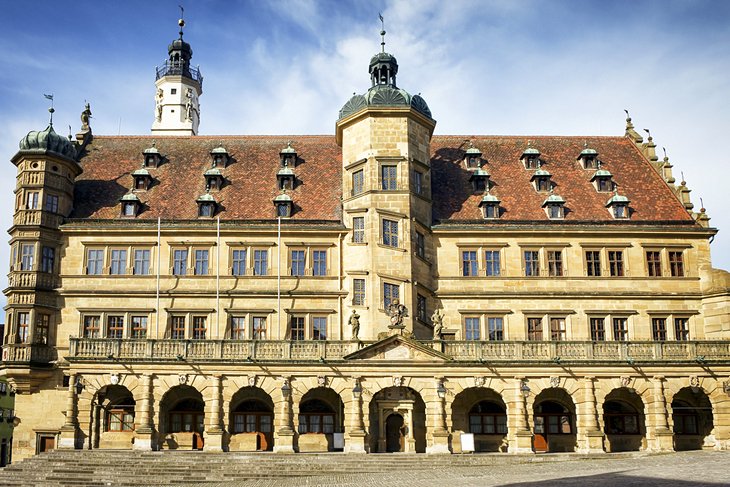
Dominating the Marktplatz at its center is the imposing Town Hall (Rathaus), one of the finest in southern Germany. The oldest part of this majestic building, constructed in the 13th century, faces Herrngasse. A later addition is the 16th-century, 50-meter-high tower, from which you'll find superb views over the Old Town.
The section facing the market was constructed in 1578 and includes the fine Imperial Hall, still used for theatrical performances and concerts. Also of interest are the former Council Tavern (Ratstrinkstube), added in 1466, and the old clock with its quaint mechanical figures.
Address: Marktplatz 1, 91541 Rothenburg ob der Tauber
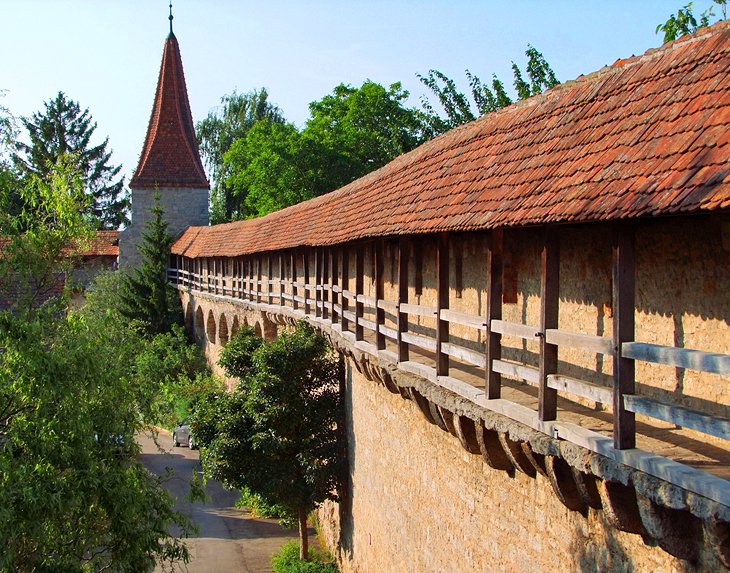
One of the most popular things to do in Rothenburg is to take the walk around the Old Town Wall and its fortifications. To see everything and complete the entire loop, including a number of raised sections along the top of the wall, you'll want to dedicate around two hours of your time (less if you only want to tackle a smaller portion).
This fascinating and attractive walk is best started from the Spitaltor in the heart of the Old Town area, a massive gatehouse built in the 1500s. From here, head toward the equally stunning Rödertor, stopping along the way to enjoy the views. The next leg leads to the Klingentor and the 15th-century St. Wolfgang's Church, which now houses an interesting museum.
In all there are 42 gatehouses and towers along the walls, so be sure to allow additional time for taking photos and stopping for some sightseeing. Also allow time to stop for a coffee and a sweet " Schneeball " deep-fried pastry treat at one of the great little cafes you'll see along the way.
Fun English language private guided tours of the Town Walls and other historic landmarks are available from the town's visitor center.
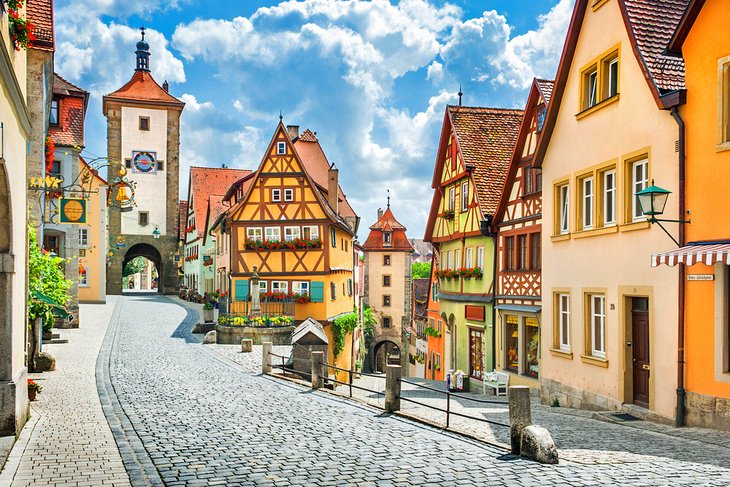
Undoubtedly the most picturesque spot in an extremely pretty town, Plönlein looks like something right out of a fairy-tale book. Literally translated as "Little Square," it's really nothing more than an intersection, but is one of the best places to visit in Rothenburg for a memorable selfie or two.
The real star here is Plönlein's brightly painted half-timbered building that divides the two streets. This tall, skinny old building dates all the way back to the 13th century and was immortalized in Walt Disney's cartoon version of Pinocchio .
Don't be shy to explore the two streets the home separates. One of them heads up through the Siebers Tower , while the other slopes down to the Kobolzeller Tower . Both towers also date from the early 13th century.
Address: u. Schmiedgasse, 91541 Rothenburg ob der Tauber
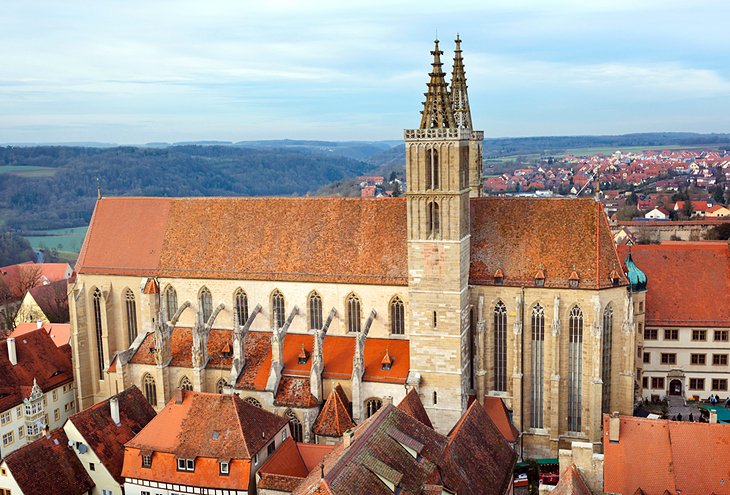
Just a short stroll from the Town Hall is the Lutheran St. James's Church. Known as Kirchengemeinde St. Jakob in German, as well as St. Jacobs, this attractive building was completed in 1485 and is widely considered to be one of the finest such pilgrimage churches in Germany.
Highlights of a visit to this historic landmark are the Altar of the Holy Blood, a superb wood carving dating from 1505 depicting the Last Supper, and the 700-year-old stained glass in the East Choir. The Twelve Apostles Altar shows the oldest known representation of Rothenburg.
English-language guided tours and audio tours are available.
Address: Klostergasse 15, 91541 Rothenburg ob der Tauber
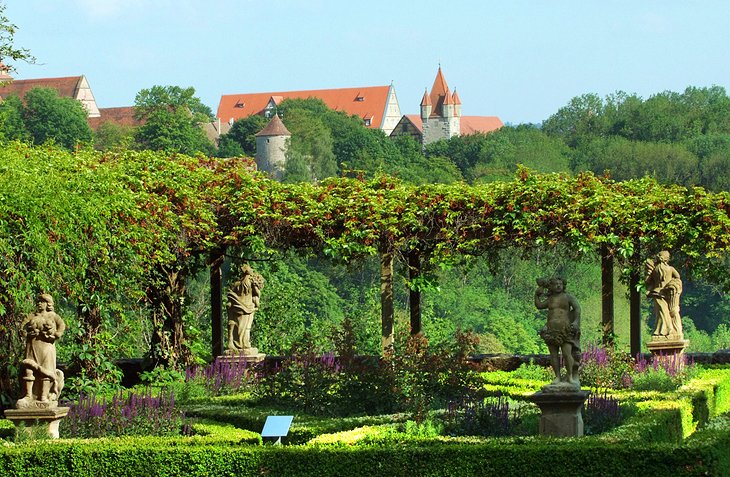
In addition to its fine old architecture, you'll also find several lovely parks and gardens in Rothenburg, each just waiting to be explored.
One of the most popular is the spectacular Castle Garden (Burggarten). Laid out on the site of a castle destroyed in an earthquake in 1356, the gardens offer wonderful views of the Old Town and the famous Double Bridge farther down the Tauber Valley.
Its geometric flower beds, laid out in the 17th and 18th centuries, include eight sculptures representing the four seasons and the four elements. Other monuments of note are one dedicated to the 14th-century Mayor Toppler and the lords of the old castle, the once-dominant Hohenstaufen dynasty.
This large green space features plenty of trees and is perfect for an impromptu picnic. Grab yourself some savory sandwiches and sweet pastries from traditional bakeries such as the popular Brot & Zeit , then grab a bench or a shady spot and feel like a European as you soak up the atmosphere of this amazing historic town.
Address: Alte Burg, 91541 Rothenburg ob der Tauber
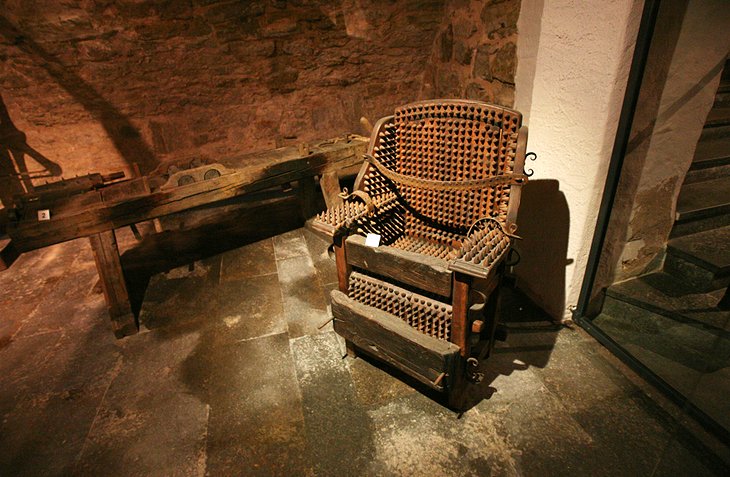
The fascinating Medieval Crime Museum (Mittelalterliches Kriminalmuseum) deals with more than 1,000 years of crime and punishment in Europe. Particular focus is placed on the medieval period.
Highlights include artifacts used to extract confessions and inflict punishment, many of them extremely gruesome. Also interesting is the fascinating documentation and details pertaining to the often-flawed logic behind their use.
Numerous notorious criminal cases are depicted in woodcuts and copper etchings, while another exhibit deals specifically with the terrible witch-hunts that once gripped Bavaria.
Address: Burggasse 3, 91541 Rothenburg ob der Tauber
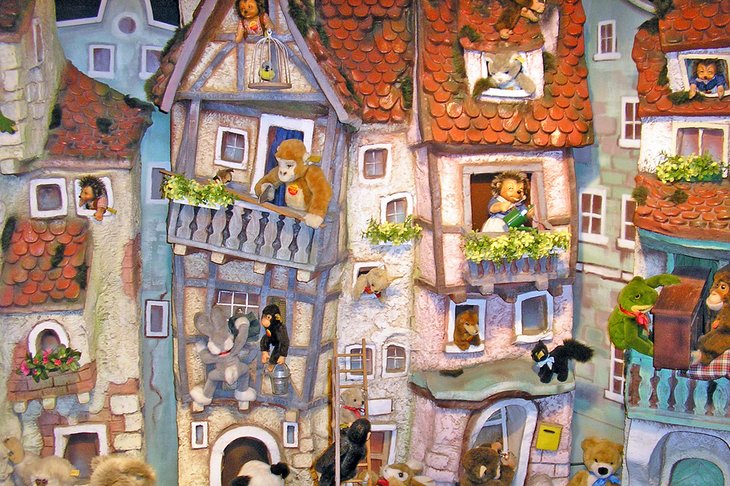
Rothenburg's Marktplatz is the scene of one of Germany's most popular Christmas markets , a tradition that can be traced to medieval times. But you can experience some of the season's colors and traditions all year round at the German Christmas Museum (Deutsches Weihnachtsmuseum).
Part store and part museum, it displays seasonal decorations and artifacts focusing on local traditions in towns like Rothenburg. Highlights include tree ornaments, nativity scenes, and numerous old figurines, including 150 figures of Father Christmas himself.
If you can, visit during the lead-up to Christmas when the town is festooned with more than 80,000 candles and four kilometers of decorations and lights.
Address: Herrngasse 1, 91541 Rothenburg ob der Tauber
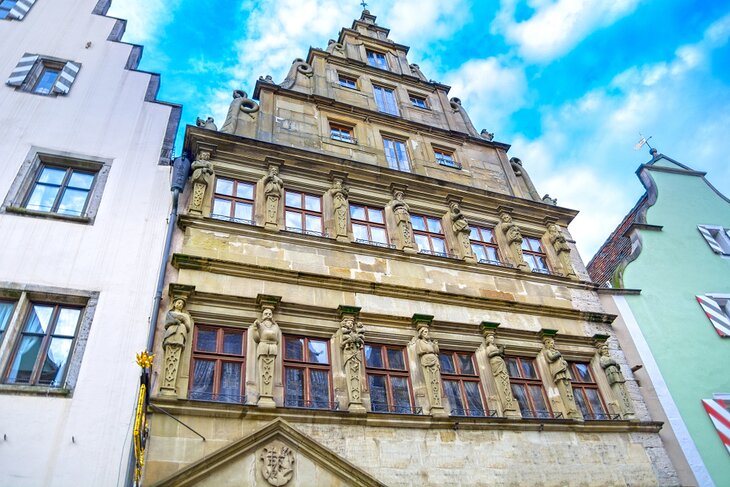
Strolling along the Schmiedgasse, a fine old street running south from the Marktplatz, you'll come to No. 3, the Master Builder's House (Baumeisterhaus). Now a hotel and restaurant, this fine old building with its spectacular façade from 1596 is widely considered to be one of the finest Renaissance houses in Bavaria.
It was here that Rothenburg's Master Builder, Leonard Weidmann, lived and worked. A testament to his skills, the house is famous for its carvings of dragon motifs, along with statues representing the seven cardinal virtues and the seven deadly sins.
Address: Ob. Schmiedgasse 3, 91541 Rothenburg ob der Tauber, Germany
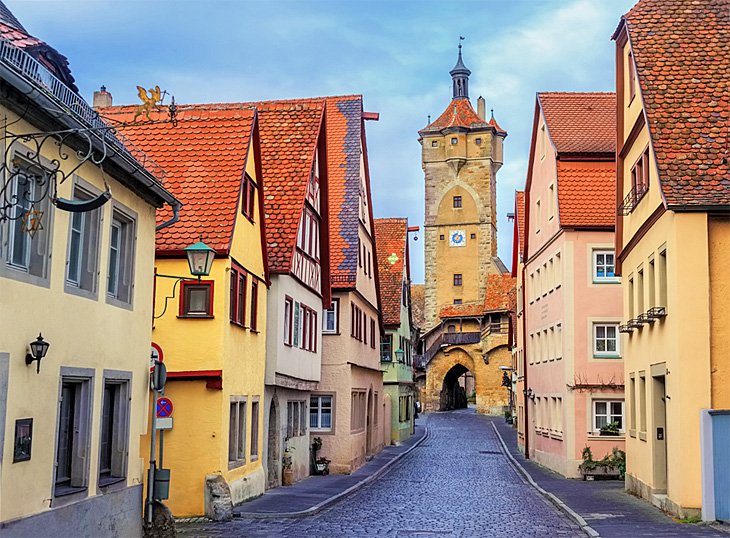
Constructed between 1395 and 1400, the imposing Klingentor is one of the most architecturally interesting of all Rothenburg's towers. Sitting alongside St. Wolfgang's church, it forms a gate in the town walls that's just begging to be explored.
It also served another purpose as well: as a water tower. It contains a huge copper tank that feeds the town's fountains. You can climb it for a small fee to see views across the town and Tauber Valley.
Address: Klingengasse 15, 91541 Rothenburg ob der Tauber, Germany
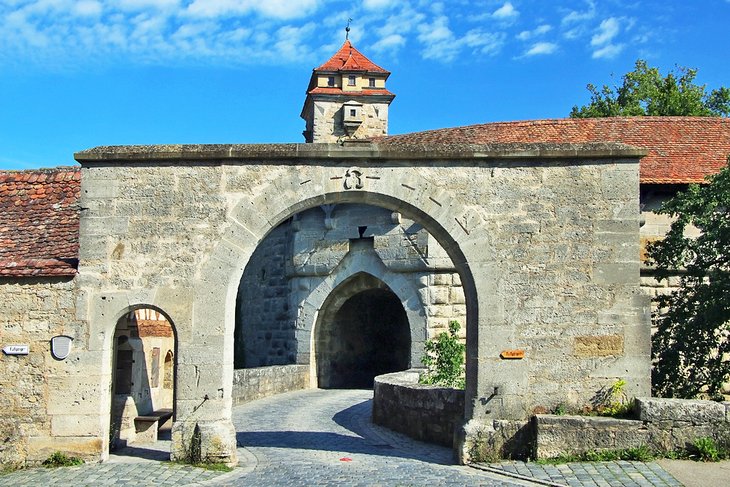
In the picturesque Spitalhof are a number of interesting buildings worth visiting. In addition to the Hegereiterhäuschen, a fine old home built in 1591, there's the massive 16th-century Spital Gate (Spitaltor), both built by Master Builder Leonhard Weidmann.
The last of the town's many fortifications to be constructed, Spitaltor bears the Latin inscription, Pax intrantibus, salus exeuntibus ; this literally translates as "Peace to those who enter in, good health to those who leave again."
Constructed in the shape of a figure eight, these intimidating fortifications include seven gates, a drawbridge, a portcullis, and a parapet.
Address: Spitalgasse 55, 91541 Rothenburg ob der Tauber, Germany
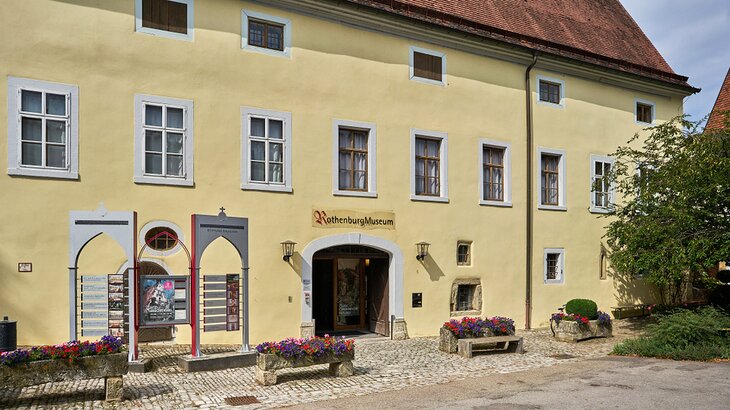
Housed in a former Dominican convent, Rothenbu rg Museum gives a better understanding of the importance of this beautiful old town. Established in 1936, the museum details life in the convent, which was dissolved in the 16th century, including a look at the historic living quarters.
Other features are the well-preserved 13th-century kitchen and the 14th-century panels of the Rothenburg Passion. The museum's Judaica Department contains artifacts showcasing the town's Jewish heritage, and the display of European weaponry, from the Stone Age to the 19th century, which includes hunting weapons once used by Frederick the Great.
Address: Klosterhof, 91541 Rothenburg ob der Tauber
All this delightful town's attractions are inside or right along the old town walls, within a few minutes' walk of each other. Several are within sight of the Marktplatz, where a surprising number of hotels also cluster. Rarely are there so many opportunities to stay in historic half-timbered buildings right in the center of a walled medieval town. Here are some highly-rated hotels in Rothenburg:
Luxury Hotels :
- A few steps from the Christmas Museum and Burg Garden, Hotel Herrnschloesschen offers guests free breakfast. So does the Historikhotel Gotisches Haus , a beautifully decorated historic building in the same area.
- Built into town walls nearby, the Burghotel overlooks the Tauber Valley with spectacular views from its terrace and well-furnished rooms.
Mid-Range Hotels:
- Just outside the walls at the entrance to the old town, Hotel-Garni Hornburg is a beautiful and hospitable manor house with large, nicely furnished rooms.
- The family-run Hotel Reichsküchenmeister , in a half-timbered house just off the market square in the center of town, has a good traditional restaurant and includes breakfast.
- In the newer part of town, only a few blocks from Marktplatz on the way from the rail station, Villa Mittermeier Hotel & Restaurant offers guests free parking. The old-fashioned Hotel Eisenhut is in a historic building next to the Christmas Museum and just off Marktplatz.
Budget Hotels:
- Between the Christmas Museum and Burg Garden, Hotel Klosterstueble is in a traditional building with a cozy courtyard and quirky rooms.
- Antiques furnish the Hotel Spitzweg , on a small quiet street a block off Marktplatz, where hospitable hosts offer free parking, an unusual feature right in the center of town.
- Near the town gate, a five-minute walk from Marktplatz, Hotel-Gasthof Klingentor has spacious rooms and also includes free parking, along with breakfast.
- Day Tour from Munich: Rothenburg is a highlight of the Romantic Road, a tourist route through some of Germany's most charming medieval towns. You can follow this route by air-conditioned coach on the Romantic Road, Rothenburg, and Harburg Day Tour from Munich . There's time to stroll through Rothenburg's streets at leisure and discover its historic sights. A bonus of the tour is a stop at the 11th-century Harburg Castle, one of Germany's oldest fortifications.
- Day Tour from Frankfurt: Combine your visits to two of Germany's most popular attractions on the Frankfurt Super Saver: Neuschwanstein Castle and Rothenburg Day Trip , a 24-hour guided excursion by coach. Skip-the-line admission to Neuschwanstein and a professionally guided walking tour of Rothenburg are included, along with round-trip transportation from central Frankfurt.

More on Germany


Private Florence Sightseeing 3-Hour Walking Tour
Discover the timeless allure of Florence through a meticulously crafted private walking tour . Designed for an intimate group of up to two participants, this exclusive experience offers a unique opportunity to uncover the city’s iconic landmarks, rich history, and artistic legacy. With a knowledgeable guide fluent in multiple languages, you’ll embark on a captivating journey, delving into the Medici family’s influence and enjoying the city’s captivating charm. Complemented by convenient hotel pickup, this customizable tour promises a personalized exploration that will leave you eager to…
- Comprehensive 3-hour private walking tour of Florence’s iconic landmarks, including the Cathedral, Baptistery, Piazza della Signoria, and Ponte Vecchio.
- Multilingual expert guide provides in-depth insights into the city’s history, art, and Medici family influence during the Renaissance era.
- Flexible and customizable itinerary with options for VIP access to museums like the Duomo and Accademia Gallery.
- Hassle-free hotel pickup service ensures a seamless start to the immersive tour experience.
- Flexible cancellation policy and reliable operation in all weather conditions, providing peace of mind for travelers.
More tours and experiences nearby.
- Tuscany Day Trip From Florence: Siena, San Gimignano, Pisa and Lunch at a Winery
- Cinque Terre Day Trip From Florence With Optional Hiking
- The Best Tour in Florence: Renaissance & Medici Tales – Guided by a STORYTELLER
- The Best Tour in Florence: Renaissance and Medici Tales
Tour Overview
What does the Private Florence Sightseeing 3-Hour Walking Tour entail?
The tour offers an intimate exploration of Florence’s iconic landmarks over a 3-hour duration. Priced at $291.04 per group of up to 2 participants, the experience includes hotel pickup in the city.
Visitors can enjoy the rich tapestry of Florentine art and architecture, guided by an expert in English, French, Italian, Portuguese, Spanish, or Russian.
The comprehensive itinerary covers must-see sites like the Cathedral, Baptistery, Piazza della Signoria, and Ponte Vecchio. Guests may also gain VIP access to renowned museums like the Duomo and Accademia upon request.
With a flexible, customizable format, this private walking tour offers an unparalleled insider’s perspective of Florence.
Pricing and Duration
The Private Florence Sightseeing 3-Hour Walking Tour comes at a price of $291.04 per group, catering to up to 2 participants.
This 3-hour experience allows visitors to explore Florence’s rich history and iconic landmarks with a private guide . The tour is offered in multiple languages, including English, French, Italian, Portuguese, Spanish, and Russian, ensuring a personalized experience for all guests.
Pickup from your hotel in Florence is included, making the tour convenient and hassle-free.
Whether you’re a first-time visitor or a seasoned traveler, this private walking tour promises an immersive and unforgettable exploration of the city’s art, architecture, and culture.
Language Options

The tour’s language options cater to a diverse range of international visitors , offering guided experiences in English, French, Italian, Portuguese, Spanish, and Russian.
This diverse language selection ensures that travelers from around the world can fully enjoy Florence’s rich history and culture, without any language barriers.
The multilingual guides provide a personalized and engaging experience , allowing guests to:
- Delve deeper into the city’s architectural wonders and artistic masterpieces
- Gain invaluable insights into the Medici family’s influence and the Renaissance era
- Navigate the city’s cobblestone streets with ease, discovering hidden gems
- Ask questions and engage in thoughtful discussions about Florence’s past and present
Hotel Pickup Included
As a convenient feature, the Private Florence Sightseeing Tour includes hotel pickup, allowing guests to commence their exploratory journey without the hassle of navigating the city’s streets on their own. This service ensures a seamless start to the tour, with a local guide greeting participants directly at their accommodation in Florence. The pickup is available across the city, catering to guests staying in various hotels or vacation rentals. This added convenience eliminates the need for independent transportation, allowing visitors to fully enjoy the tour experience from the very beginning.
Key Landmarks Explored
On the Private Florence Sightseeing Tour , visitors are treated to an immersive exploration of the city’s most iconic landmarks.
The guided journey takes guests through the towering Cathedral, revered for its magnificent Renaissance dome designed by Brunelleschi.
Next, the tour meanders to the Baptistery, renowned for its ornate bronze doors.
At the Piazza della Signoria, the political heart of Florence since the 1300s, the guide delves into the captivating history of the Medici family.
The tour culminates at the iconic Ponte Vecchio, the oldest bridge in the city, offering a unique perspective on Florence’s rich architectural tapestry.
The tour provides an insightful glimpse into:
- Florence’s architectural masterpieces
- The influential Medici dynasty
- The city’s vibrant political history
- Ponte Vecchio’s enduring legacy
Customizable Itinerary
Visitors on the Private Florence Sightseeing Tour enjoy a highly customizable experience tailored to their interests. The itinerary is flexible, allowing guests to focus on the sites and attractions they find most appealing.
Whether it’s exploring the Duomo or visiting Michelangelo’s David, the knowledgeable guide works closely with participants to curate the perfect 3-hour journey through Florence’s historic streets and piazzas.
This personalized approach ensures travelers make the most of their time, seeing the highlights while also discovering hidden gems off the beaten path.
The tour’s adaptability is a major draw, enabling visitors to craft an unforgettable experience that aligns with their individual preferences.
Cancellation and Weather Policy
The Private Florence Sightseeing Tour offers a flexible cancellation policy , allowing travelers to receive a full refund if they cancel up to 2 days in advance.
This policy provides peace of mind and flexibility, ensuring customers can plan their trip with confidence.
Plus, the tour operates in all weather conditions , rain or shine.
This commitment to delivering an exceptional experience regardless of the weather demonstrates the tour provider’s dedication to customer satisfaction .
The tour’s weather policy reflects their understanding of the unpredictable nature of travel and their willingness to accommodate unforeseen circumstances , further enhancing the overall value of the experience.
- Flexible cancellation policy up to 2 days in advance
- Full refund available with timely cancellation
- Tour operates in all weather conditions
- Dedication to customer satisfaction
Customer Feedback
Travelers who’ve experienced the Private Florence Sightseeing Tour have provided overwhelmingly positive feedback, with the tour earning a remarkable 5/5 overall rating based on a single review.
Reviewers praised the knowledgeable and engaging guides , who captivated them with detailed stories about the Medici family and Florence’s rich history. The value for money was rated 4/5, reflecting the personalized nature of the tour.
Customers were also highly satisfied with the tour’s organization, noting the seamless pickup from their hotel .
Here's a few more nearby tours and experiences we think you'll like.
- Florence Pizza or Pasta Class With Gelato Making at a Tuscan Farm
- Small-Group Wine Tasting Experience in the Tuscan Countryside
- Cooking Class and Lunch at a Tuscan Farmhouse With Local Market Tour From Florence
- Chianti Safari: Tuscan Villas With Vineyards, Cheese, Wine & Lunch From Florence
- Florence Vespa Tour: Tuscan Hills and Italian Cuisine
- Uffizi Gallery Small Group Tour With Guide
Frequently Asked Questions
Is this tour suitable for children.
The tour may not be the most suitable for children, as it focuses on in-depth exploration of Florence’s art and history. However, the guide can likely adapt the experience to accommodate families with kids upon request.
Can the Tour Be Extended Beyond 3 Hours?
Yes, the tour can be extended beyond the standard 3 hours. Customers can work with the tour operator to customize the itinerary and duration to accommodate their interests and needs. Additional fees may apply for an extended tour.
Are Restrooms Available During the Tour?
The tour itinerary does not explicitly mention restroom stops, but it’s likely guides can accommodate brief breaks as needed. Participants should feel free to inquire about restroom access when booking the tour.
Can I Take Photos Inside the Museums?
Visitors can typically take photos inside the museums on the tour, but they should check with their guide first. Some museums may have restrictions or require visitors to purchase a photography permit for an additional fee.
Is the Guide Able to Provide Recommendations for Local Dining?
The guide can likely provide recommendations for local dining spots, as they are knowledgeable about the city and its culinary scene. They may suggest authentic restaurants, hidden gems, or eateries favored by locals to enhance the visitor’s Florence experience.
Not for you? Here's more of our most recent tour reviews happening neaby
- Inferno Florence Private 3-Hour Tour
- Tuscany: Cruise With Lunch and a Drink
- Private Florence Duomo Tour With Dome Climb
- Discover Tuscany: Florence & Chianti Day Trip
- Florence: Wineries, Tastings, Lunch & San Gimignano Day Trip
- From Florence: Chianti Wine Tastings at Sunset Day Trip
- From Florence: Siena, Cortona, Montepulciano & Val DOrcia
- 2-Hour Vintage Fiat 500 Tour With Olive Oil Tasting at Farm
- Biodynamic Chianti Wine Experience, a Day in Chianti
- Florence: Market and Cooking Class at a Locals Home
- Golf Cart Tour In Florence
- Florence: Private 3-Hour Walking Tour
- Montalcino: Small-Group Brunello Wine Tour From Florence
- Florence: Private Accademia Gallery Tour
- Florence: Tour for Kids W/ Michelangelo Statue of David
The Private 3-Hour Florence Walking Tour provides an exclusive and personalized exploration of the city’s iconic landmarks. With a customizable itinerary , expert guiding , and hotel pickup, visitors can enjoy the captivating charm of Florence, learning about its rich history, art, and the influential Medici family. This tour offers a comprehensive, insider’s perspective on the city’s most significant sights, ensuring a memorable and tailored experience.
Similar Posts

Day Trip Natural Beauty of Jermuk: Noratus, Hayravank, Selim Pass

Hobart: Luxury Yacht Scenic Sailing Tour With Snacks
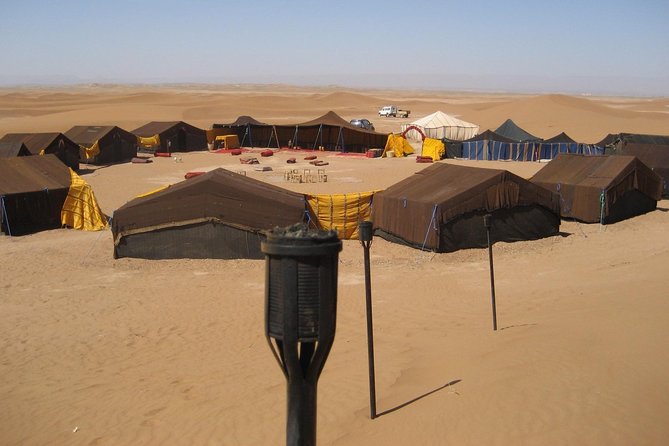
2-Day Zagora Desert Tour From Marrakech

Frascati Wine Tasting Tour: The Flavors of the Roman Countryside

Cancun Seaside Parasailing and Maya Ruins Combo

Highlights & Hidden Gems With Locals: Best of Berlin Private Tour

IMAGES
VIDEO
COMMENTS
Walking Tour Location: Old Town Rothenburg Cost: Free, Self-Guided (Museum and funicular/lift costs below) Style: Do-It-Yourself Walking Tour (Self Guided) Start: Market Square (Marktplatz) End: Plönlein Corner Walking Distance: 1.1 miles (+0.6 miles for Infirmary Quarter; +0.6 miles for short wall walk) Time Required: 60 Minutes for Walk (2-3 hours with sights; +1 hour for each of the 3 ...
This two-hour walking tour offers a delightful journey through Rothenburg's medieval streets, showcasing its well-preserved architecture, rich history, and captivating landmarks. Step into a fairy tale with our self-guided walking tour of Rothenburg ob der Tauber. Wander through this medieval town's enchanting streets and historic sites ...
A Rothenburg ob der Tauber Walking Tour (+ Map) It's a breeze to explore Rothenburg in one day on foot. The main sights in town are no more than a 15-minute walk from each other or the train station. If you like to map it out, here's one that includes the attractions recommended in this guide.
Rothenburg ob der Tauber Walking Tour Route. This walking tour starts from the Röderturm. It heads first into Rothenburg Altstadt* before heading around the medieval city walls An extension heads across the Tauber River Valley for great views back to Rothenburg and of the historic Double Decker bridge.. 1. Röderturm. The Röderturm* is a grand old entrance to Rothenburg.
Experience Rothenburg ob der Tauber by night while hearing about its medieval past. Learn from your night watchman guide the important duties of a watchman and the greatest dangers a medieval town can face. Wander through tranquil squares and deserted alleys on this PRIVATE 1-hour tour.
In this tour, you will be visiting the best attractions and wonderful heritage sites of Rothenburg ob der. from. $358. per group. 5. Rothenburg ob der Tauber Christmas Market Private Walking Tour. 5. Private and Luxury. 1-2 hours.
Walking Tour Location: Rothenburg City Wall Trail (Turmweg) Cost: Free, Self-Guided (Museum and funicular/lift costs below) Style: Do-It-Yourself Walking Tour (Self Guided) Start: Old Town Square (Marktplatz) End: Saint Wolfgang Church (St. Wolfgangskirche) Walking Distance: 2.9 miles for the full circle route (+0.9 for Old Mills; +0.3 for Toppler Palace)
A walking tour helps bring the ramparts alive. For the serious side of Rothenburg's history, you can take the tour offered by the town's tourist office. But for a thoroughly fun hour of medieval wonderment, take the Night Watchman's Tour. The watchman jokes like a medieval John Cleese as he stokes his lamp and takes tourists on his rounds, all ...
The Night Watchman is a German guy with excellent English speaking and storytelling skills, who will teach you all about the rich history of Rothenburg ob der Tauber. He does this whole educational, entertaining tour from the perspective of a Medieval times city night watchman! These guys patrolled the gates of a city back in the day, and knew ...
Immerse yourself in the enchanting Old Town of Rothenburg ob der Tauber with a personalized and relaxed private walking tour led by a knowledgeable local guide. Discover the city's rich history, culture, and traditions as you explore important landmarks such as the town hall, market square with the Council Drinking House, and the George Fountain.
April 29, 2020 by Henk Bekker. Walking on the sentry walk on the walls and ramparts of Rothenburg ob der Tauber is free and a top attraction when visiting the romantic, wall-enclosed medieval town. Romantic Rothenburg ob der Tauber, at the heart of the Romantische Straße tourist route in Germany, is famous for its beautifully preserved picture ...
This private tour is entirely customizable and can be adjusted to suit your preferences on the day. Options include climbing to the top of the Town Hall Tower, exploring the Medieval Crime Museum, or trying a local pastry known as a snowball. Your walking tour of Rothenburg on der Tauber ends back at the Market Square, the perfect central ...
Explore Rothenburg ob der Tauber on a relaxed and customized private walking tour with a professional local guide. See important sites and learn about the history, culture, and traditions of the city. Search. Become a supplier ... Tours in Rothenburg ob der Tauber. Top Attractions in Rothenburg ob der Tauber. 1 Plönlein. 2 Medieval Crime ...
Guide Name: Old Town Gates and Towers Walking Tour. Guide Location: Germany » Rothenburg (See other walking tours in Rothenburg) Guide Type: Self-guided Walking Tour (Sightseeing) # of Attractions: 10. Tour Duration: 2 Hour (s) Travel Distance: 2.9 Km or 1.8 Miles. Author: nataly. Sight (s) Featured in This Guide:
Please also check our new channel: @AdventureHunterTV We recorded this 4k ultra hd video during our trip to Rothenburg, Germany on August 2020. Located on a ...
Marktplatz 2. 91541 Rothenburg ob der Tauber. 09861 404-800. 09861 404-529. [email protected]. From November to April. From May to September 8th. September 9th to the end of October. From the classic daytime city tour to the night watchman tour - get to know Rothenburg ob der Tauber with our tour guides.
Self-Guided Walking Tours to Explore Rothenburg, Germany Follow these 2 expert-designed self-guided walking tours to explore Rothenburg, Germany on foot at your own pace. You can also create your own self-guided walk to visit the city attractions which interest you the most.
In the Middle Ages, when Berlin and Munich were just wide spots on the road, Rothenburg ob der Tauber was one of Germany's largest towns, thanks to its strategic position on the trade routes between northern and southern Europe. Today, it's the country's best-preserved medieval walled town, enjoying tremendous tourist popularity without losing its charm. While roughly 2 million people visit ...
Day Tour from Frankfurt: Combine your visits to two of Germany's most popular attractions on the Frankfurt Super Saver: Neuschwanstein Castle and Rothenburg Day Trip, a 24-hour guided excursion by coach. Skip-the-line admission to Neuschwanstein and a professionally guided walking tour of Rothenburg are included, along with round-trip ...
Recap. The Private 3-Hour Florence Walking Tour provides an exclusive and personalized exploration of the city's iconic landmarks. With a customizable itinerary, expert guiding, and hotel pickup, visitors can enjoy the captivating charm of Florence, learning about its rich history, art, and the influential Medici family.This tour offers a comprehensive, insider's perspective on the city ...
The best indoor activities in Rothenburg ob der Tauber for rainy days are: From Munich: Rothenburg and Nördlinger Ries Day Trip by Bus. Nuremberg Old Town and Nazi Rally Grounds Walking Tour. Frankfurt: Romantic Road & Rothenburg ob der Tauber Tour. From Frankfurt: Heidelberg & Rothenburg Full-Day Tour.